American Bonsai at the NC Arboretum
+95
kingsnake
Tom
MKBonsai
BrianS
manumidam
Chris Cochrane
Intricate Simplicity
chench53
KyleT
Maros Belan
DjTommy
Bolero
Gonetopot
Rick36
M. Frary
Van
Toshiro
fiona
Precarious
drbuzzbee
geo
LanceMac10
MichaelS
kimo
Chellis
Leo Schordje
FrankP999
dick benbow
BrianG
crust
TN Jim
Seth Ellwood
Wander
peterkang
Judgie
Kevin S - Wisco Bonsai
Vance Wood
JMcCoy
brett2013
GerhardGerber
lordy
Eric Group
my nellie
steveb
Jaybird
Todd Ellis
jgeanangel
Daygan
AlainK
Richard S
Randy_Davis
Robert J. Baran
David Brunner
William N. Valavanis
Jkd2572
Dale Cochoy
Jesse McMahon
prestontolbert
yamasuri
bingregory
Stephen Krall
DougB
Ashiod
JADunnagan
sayotefries
JudyB
Dan W.
Khaimraj Seepersad
DuncanJH
Dave Murphy
monte
MikeG
augustine
Russell Coker
Kev Bailey
lennard
BigDave
Marty Weiser
Smithy
coh
tmmason10
dorothy7774
gman
Dave Leppo
hometeamrocker
bwaynef
Billy M. Rhodes
Walter Pall
Sam Ogranaja
JimLewis
MartinSweeney
bonsaisr
Auballagh
John Quinn
Arthur Joura
99 posters
Page 2 of 40
Page 2 of 40 •  1, 2, 3 ... 21 ... 40
1, 2, 3 ... 21 ... 40 
 Re: American Bonsai at the NC Arboretum
Re: American Bonsai at the NC Arboretum
Arthur Joura wrote:
Big Dave, I am glad you found the story of my start in bonsai to be encouraging as you begin your own curatorial adventure. Thank you for including the link to the site showing the trees in your collection.
Thanks Arthur,
Most kind to look at the trees, and thanks again for the before and afters photos.
I am encouraged ! By putting together a team and plan, several new better pots, the most needy have been repotted,
we are on our way.
This is a good thing, maybe a new bonsai display is coming...
http://japandailypress.com/3m-pledged-by-kyoceras-inamori-to-san-diegos-japan-friendship-garden-0926623
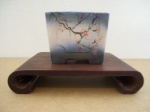
BigDave- Member
 Random Images From the Ongoing Bedlam of Spring
Random Images From the Ongoing Bedlam of Spring
Last Saturday we celebrated World Bonsai Day here at the NC Arboretum, with the help of Felix Laughlin of the World Bonsai Friendship Federation. Felix delivered an image show while speaking about Saburo Kato and the origin and purpose of World Bonsai Day, and I did a demonstration using a nice Dawn Redwood (Metasequoia glyptostroboides) that Felix donated for the occasion. We limited the program to NC Arboretum members, and still drew a good crowd of more than 80 people:
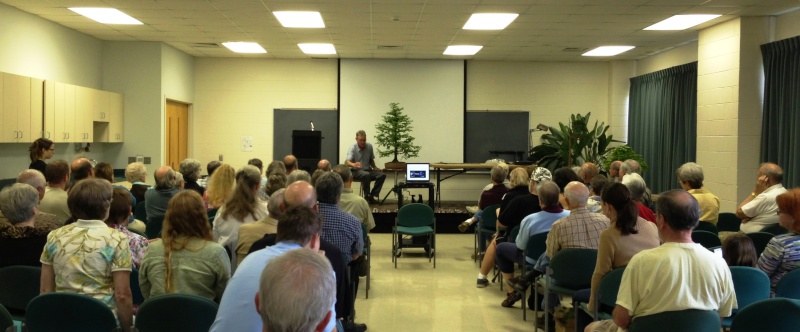
We have a 100' long hoop house where we keep bonsai that are not on display at the Bonsai Exhibition Garden. In the winter the structure is covered with white poly to protect the plants from weather extremes, and in the spring I gradually reintroduce the sunlight by cutting circular holes in the plastic. This goes on for several weeks as I cut more an more holes to allow more and more sunlight to enter. Eventually we have a bonsai holey house, and it looks like this:
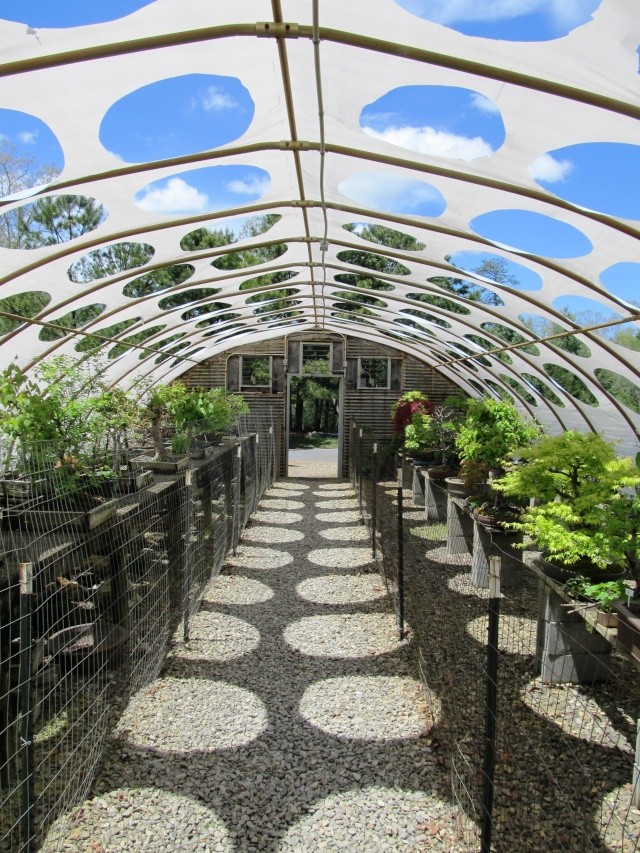
At this riotous time of year the Bonsai Exhibition Garden changes its look just about every week:
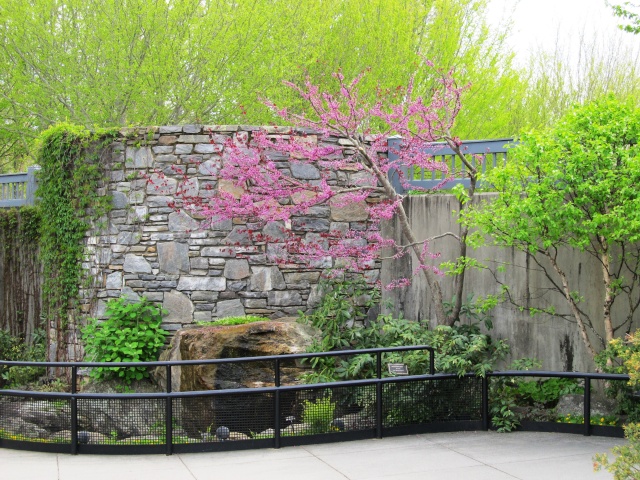
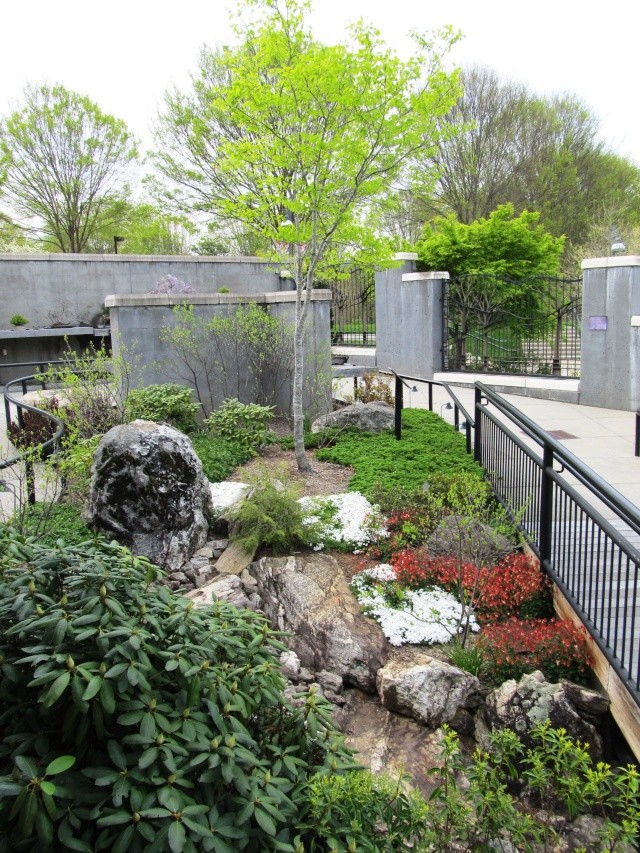
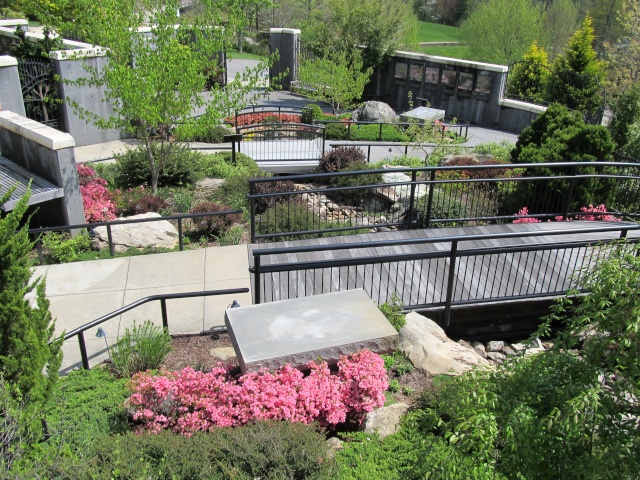
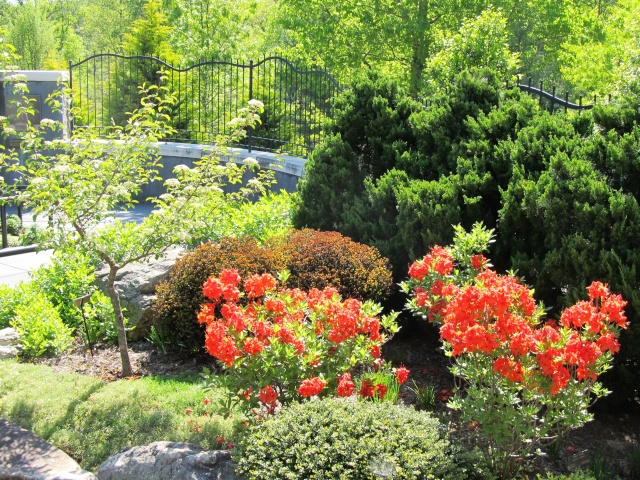
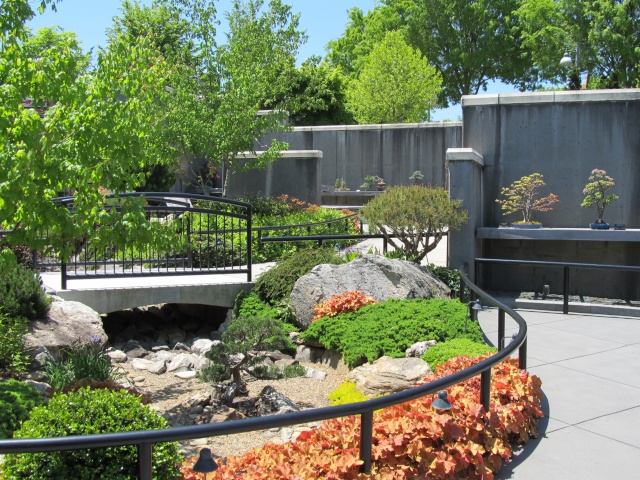
The bonsai have been gradually reappearing on the display benches, although we still do not have all the spaces filled. What follows are a few images of specimens currently on display.
Cut-leaf Japanese Maple (Acer palmatum v. dissectum atropurpureum):

"Roan Mountain" tray landscape, featuring Shimpaku Juniper (Juniperus chinensis 'Shimpaku') and Zakura Azalea (Rhododendron kiusianum 'Zakura'):
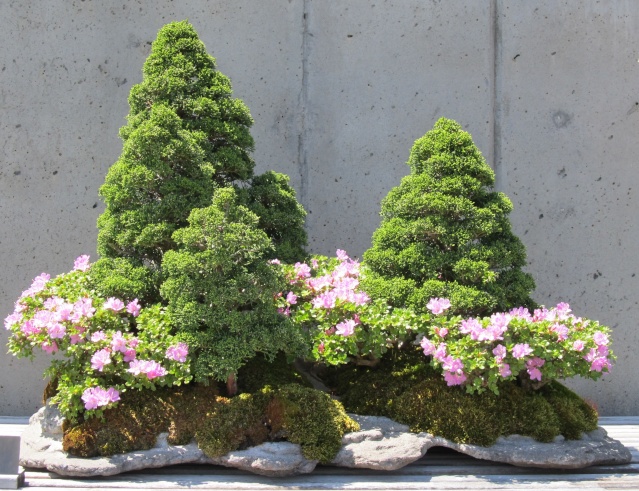
Lilly of the Valley (Convallaria majalis):

Yellowroot (Xanthorhiza simplicissima) and Creeping Bluet (Hedyotis michauxii):
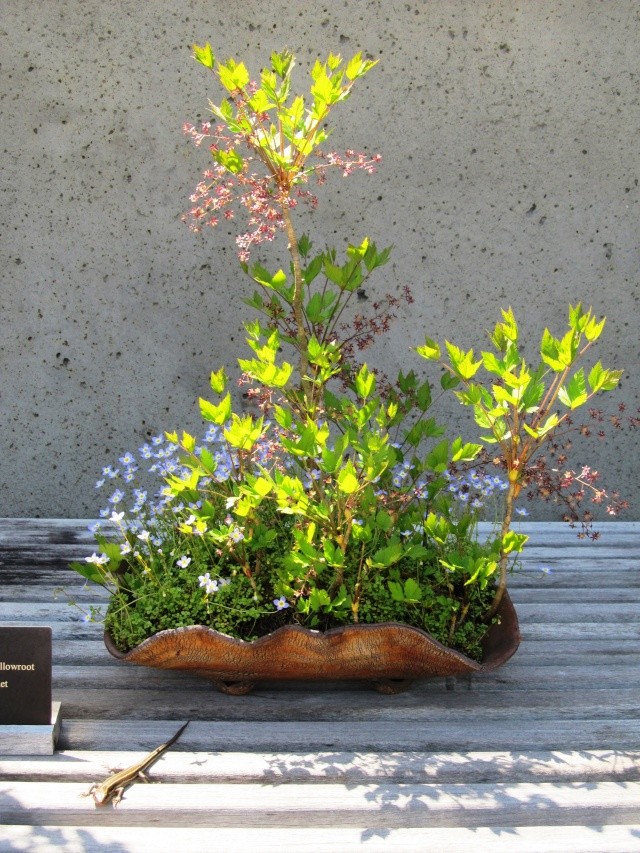
Japanese White Pine (Pinus parviflora):
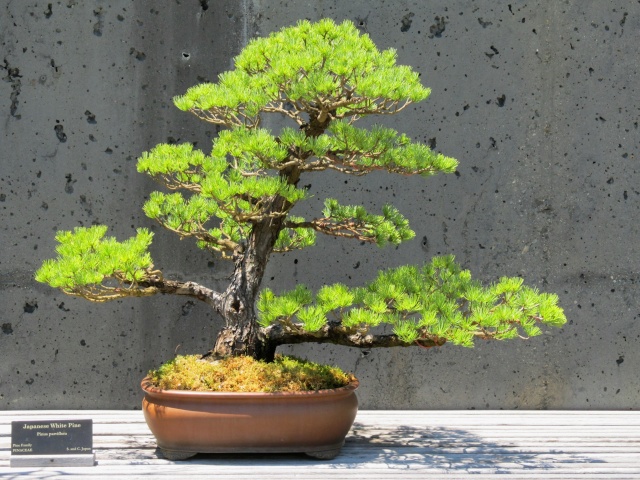
"Appalachian Cove" tray landscape, featuring 5 different species native to the Southern Appalachian Mountains, with Red Maple (Acer rubrum) providing the much of the color and American Hornbeam (Carpinus caroliniana) being the one with the large, hollowed out trunk:

And finally, because we go to great lengths to avoid using pesticides in the Bonsai Exhibition Garden, it is a place teeming with all sorts of life. The 3 pictures that follow I think of as "the birds & the bees (& the skinks)".
A Chipping Sparrow at the water feature:
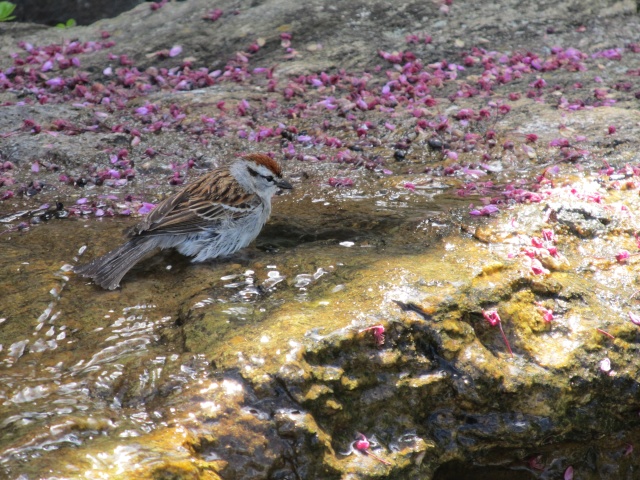
Bumblebees working the Crossvine (Bignonia capreolata):
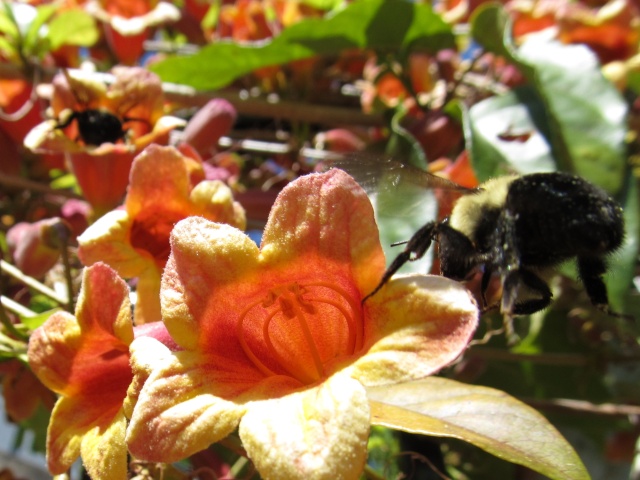
And a couple of Broadhead Skinks, "wrestling" in the dry stream:


We have a 100' long hoop house where we keep bonsai that are not on display at the Bonsai Exhibition Garden. In the winter the structure is covered with white poly to protect the plants from weather extremes, and in the spring I gradually reintroduce the sunlight by cutting circular holes in the plastic. This goes on for several weeks as I cut more an more holes to allow more and more sunlight to enter. Eventually we have a bonsai holey house, and it looks like this:

At this riotous time of year the Bonsai Exhibition Garden changes its look just about every week:





The bonsai have been gradually reappearing on the display benches, although we still do not have all the spaces filled. What follows are a few images of specimens currently on display.
Cut-leaf Japanese Maple (Acer palmatum v. dissectum atropurpureum):

"Roan Mountain" tray landscape, featuring Shimpaku Juniper (Juniperus chinensis 'Shimpaku') and Zakura Azalea (Rhododendron kiusianum 'Zakura'):

Lilly of the Valley (Convallaria majalis):

Yellowroot (Xanthorhiza simplicissima) and Creeping Bluet (Hedyotis michauxii):

Japanese White Pine (Pinus parviflora):

"Appalachian Cove" tray landscape, featuring 5 different species native to the Southern Appalachian Mountains, with Red Maple (Acer rubrum) providing the much of the color and American Hornbeam (Carpinus caroliniana) being the one with the large, hollowed out trunk:

And finally, because we go to great lengths to avoid using pesticides in the Bonsai Exhibition Garden, it is a place teeming with all sorts of life. The 3 pictures that follow I think of as "the birds & the bees (& the skinks)".
A Chipping Sparrow at the water feature:

Bumblebees working the Crossvine (Bignonia capreolata):

And a couple of Broadhead Skinks, "wrestling" in the dry stream:

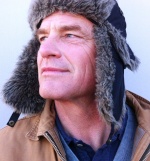
Arthur Joura- Member
 Whose Art Is It Anyway?
Whose Art Is It Anyway?
A tray landscape originally designed by bonsai great Yuji Yoshimura is currently commanding a great deal of attention in the Bonsai Exhibition Garden, because it looks like this:
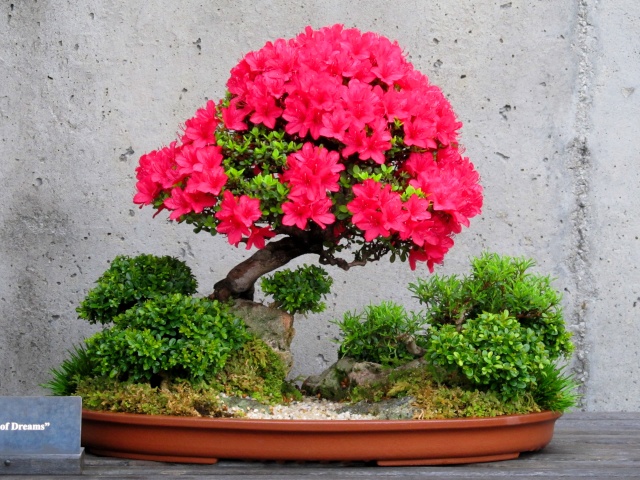
The public loves flowers! The blooming "tree" in this planting is one of the Kurume hybrids, named 'Christmas Cheer' (Rhododendron X 'Christmas Cheer'). Most of the rest of the shrubs are Kingsville Dwarf Boxwood (Buxus microphylla v. compacta), with the exception of the largest shrub on the right side of the planting. That one is another azalea, although the variety is unknown. It blooms after the 'Christmas Cheer' azalea is finished and has large pink flowers which somehow do not work at all in the context of this landscape, so its buds are clipped off each year to prevent it from flowering. Although the prime time for this tray landscape is when it is in bloom, it looks good all through the year thanks to a nicely conceived design. The white gravel in the middle of the arrangement suggests water while the rocks delineate the edges of land masses on either side. This is one of several pieces in our collection that has a poetic name, this one being known as "River of Dreams".
I started out by attributing this tray landscape to Mr. Yoshimura, which is technically correct as it was he who first put it together in a demonstration sometime in the 1980's. It was part of a program he did for the Triangle Bonsai Society in the Raleigh, NC area, just one of the countless such presentations he made during the 30-some-odd years he traveled all over the United States and elsewhere in the world educating the public about the art of bonsai. At the end of his demonstration the piece looked like this:

What a difference time makes! Only, it takes more than simply the passage of time; it takes time plus skillful care, persistently applied. Mr. Yoshimura worked on this piece only once, and that was during his demonstration, which we might assume to have been a couple or 3 hours in duration. Fortunately for this piece it went home with a man named Howard Kazan. The late Mr. Kazan was a long time member of the Triangle group and a semi-professional bonsai artist, and later became an avid supporter of bonsai at the NC Arboretum. Mr. Kazan donated this tray landscape to our collection sometime in the very early 2000's. This photograph was taken not long after the piece was given to us:

Obviously, a great deal of change occurred between the time when Mr. Yoshimura created the landscape and when Mr. Kazan donated it to the Arboretum. Some of this difference is a direct result of the plants having had a couple of decades to grow and mature, but there are other differences beyond that. You will notice in the original image there is a variegated plant on the left side of the planting that is no longer there in the later image. Several other plants also appear to be missing, or moved. Mr. Kazan informed me that the azalea originally used on the right side of the landscape died some time shortly after the piece was put together, and he replaced it with another he had on hand (the one with the large pink flowers.) Also, the configuration of the land masses is different. The stones may have been rearranged or the position of what is viewed as the front of the composition might have been rotated slightly clockwise in the container, but somehow the configuration has been changed. Let us also contemplate that part about "the plants having had a couple of decades to grow and mature". During the 20-something years they were doing that, who was holding the scissors? Whose mind made the choices about where to cut and what to remove?
The original image represents what was accomplished by Mr. Yoshimura during a 2 or 3-hour demonstration. The next image represents what Mr. Kazan accomplished over the course of more than 2 decades, working off the starting point of Mr. Yoshimura's original design.
So, is this tray landscape a Yoshimura piece, or a Kazan piece?
Before you answer that question, consider the changes that have taken place in the look of the landscape over the 10 plus-years since Mr. Kazan donated the piece to the Arboretum. For starters, it is in a different container now (the original container cracked.) The position of the stones on the right side is slightly different, too. Plus, all the plants are larger, fuller and different in feeling due to the way they are pruned. I think Mr. Kazan, if he was alive today and could see the piece, would say that everything needs a good thinning out. You might think that, too, and you may be right. If and when the time comes that the plants in the "River of Dreams" tray landscape get strongly headed back, I will be the one holding the scissors. Mr. Yoshimura might be looking over my left shoulder while I work and Mr. Kazan might be looking over my right, but neither one of them will have much say in the matter. I will make the cuts where I think they should be made. In the end, I will make the piece look the way I think it looks best, just as Mr. Kazan did, and just as Mr. Yoshimura did before him.
This is all as it should be, because this is bonsai.
When a painter puts the last stroke of the brush to the canvas, very rarely does anyone follow behind and paint over the work. The same is true for a work of sculpture, or a piece of writing. So when we say, "This is an O'Keeffe painting" or "This is a Calder mobile" or "This is a Hemingway novel", we are talking about a piece of work done by a single person. They may well have been influenced by others, but the finished piece is their original work and it stays the way they made it.
In bonsai, because the medium is alive and growing, constantly changing, it is not possible for the work of any one person to remain intact over any great length of time. The person who has a John Naka tree, for example, can in fact only have a tree that was once shaped by him. Even if Mr. Naka had the tree for 30 years and the person who has it now is keeping it strictly to the same design that Mr. Naka gave it, the tree is invariably changing. It has to. Every time we take scissors to plant we make choices, and these choices reflect our own mind and no one else's. So, what about the person who buys a tree from, say, Walter Pall, and then every year hires Mr. Pall to come and trim the tree and repot it and give advice as to how it should be handled - is that not a Walter Pall tree? Perhaps... for the time being. But it will someday have to be shaped by somebody other than him, unless it dies first... or he lives forever.
In bonsai, every piece that has been around for any substantial length of time has been influenced by each and every person who has grown it. Bonsai is a collaborative art form, not only in the sense that multiple people can and do influence any given piece, but also in the sense that the living plant material contributes its own individual nature, as well. Mmmm, interspecies art... That is an interesting topic in its own right, but it will have to wait for another day.

The public loves flowers! The blooming "tree" in this planting is one of the Kurume hybrids, named 'Christmas Cheer' (Rhododendron X 'Christmas Cheer'). Most of the rest of the shrubs are Kingsville Dwarf Boxwood (Buxus microphylla v. compacta), with the exception of the largest shrub on the right side of the planting. That one is another azalea, although the variety is unknown. It blooms after the 'Christmas Cheer' azalea is finished and has large pink flowers which somehow do not work at all in the context of this landscape, so its buds are clipped off each year to prevent it from flowering. Although the prime time for this tray landscape is when it is in bloom, it looks good all through the year thanks to a nicely conceived design. The white gravel in the middle of the arrangement suggests water while the rocks delineate the edges of land masses on either side. This is one of several pieces in our collection that has a poetic name, this one being known as "River of Dreams".
I started out by attributing this tray landscape to Mr. Yoshimura, which is technically correct as it was he who first put it together in a demonstration sometime in the 1980's. It was part of a program he did for the Triangle Bonsai Society in the Raleigh, NC area, just one of the countless such presentations he made during the 30-some-odd years he traveled all over the United States and elsewhere in the world educating the public about the art of bonsai. At the end of his demonstration the piece looked like this:

What a difference time makes! Only, it takes more than simply the passage of time; it takes time plus skillful care, persistently applied. Mr. Yoshimura worked on this piece only once, and that was during his demonstration, which we might assume to have been a couple or 3 hours in duration. Fortunately for this piece it went home with a man named Howard Kazan. The late Mr. Kazan was a long time member of the Triangle group and a semi-professional bonsai artist, and later became an avid supporter of bonsai at the NC Arboretum. Mr. Kazan donated this tray landscape to our collection sometime in the very early 2000's. This photograph was taken not long after the piece was given to us:

Obviously, a great deal of change occurred between the time when Mr. Yoshimura created the landscape and when Mr. Kazan donated it to the Arboretum. Some of this difference is a direct result of the plants having had a couple of decades to grow and mature, but there are other differences beyond that. You will notice in the original image there is a variegated plant on the left side of the planting that is no longer there in the later image. Several other plants also appear to be missing, or moved. Mr. Kazan informed me that the azalea originally used on the right side of the landscape died some time shortly after the piece was put together, and he replaced it with another he had on hand (the one with the large pink flowers.) Also, the configuration of the land masses is different. The stones may have been rearranged or the position of what is viewed as the front of the composition might have been rotated slightly clockwise in the container, but somehow the configuration has been changed. Let us also contemplate that part about "the plants having had a couple of decades to grow and mature". During the 20-something years they were doing that, who was holding the scissors? Whose mind made the choices about where to cut and what to remove?
The original image represents what was accomplished by Mr. Yoshimura during a 2 or 3-hour demonstration. The next image represents what Mr. Kazan accomplished over the course of more than 2 decades, working off the starting point of Mr. Yoshimura's original design.
So, is this tray landscape a Yoshimura piece, or a Kazan piece?
Before you answer that question, consider the changes that have taken place in the look of the landscape over the 10 plus-years since Mr. Kazan donated the piece to the Arboretum. For starters, it is in a different container now (the original container cracked.) The position of the stones on the right side is slightly different, too. Plus, all the plants are larger, fuller and different in feeling due to the way they are pruned. I think Mr. Kazan, if he was alive today and could see the piece, would say that everything needs a good thinning out. You might think that, too, and you may be right. If and when the time comes that the plants in the "River of Dreams" tray landscape get strongly headed back, I will be the one holding the scissors. Mr. Yoshimura might be looking over my left shoulder while I work and Mr. Kazan might be looking over my right, but neither one of them will have much say in the matter. I will make the cuts where I think they should be made. In the end, I will make the piece look the way I think it looks best, just as Mr. Kazan did, and just as Mr. Yoshimura did before him.
This is all as it should be, because this is bonsai.
When a painter puts the last stroke of the brush to the canvas, very rarely does anyone follow behind and paint over the work. The same is true for a work of sculpture, or a piece of writing. So when we say, "This is an O'Keeffe painting" or "This is a Calder mobile" or "This is a Hemingway novel", we are talking about a piece of work done by a single person. They may well have been influenced by others, but the finished piece is their original work and it stays the way they made it.
In bonsai, because the medium is alive and growing, constantly changing, it is not possible for the work of any one person to remain intact over any great length of time. The person who has a John Naka tree, for example, can in fact only have a tree that was once shaped by him. Even if Mr. Naka had the tree for 30 years and the person who has it now is keeping it strictly to the same design that Mr. Naka gave it, the tree is invariably changing. It has to. Every time we take scissors to plant we make choices, and these choices reflect our own mind and no one else's. So, what about the person who buys a tree from, say, Walter Pall, and then every year hires Mr. Pall to come and trim the tree and repot it and give advice as to how it should be handled - is that not a Walter Pall tree? Perhaps... for the time being. But it will someday have to be shaped by somebody other than him, unless it dies first... or he lives forever.
In bonsai, every piece that has been around for any substantial length of time has been influenced by each and every person who has grown it. Bonsai is a collaborative art form, not only in the sense that multiple people can and do influence any given piece, but also in the sense that the living plant material contributes its own individual nature, as well. Mmmm, interspecies art... That is an interesting topic in its own right, but it will have to wait for another day.

Arthur Joura- Member
 Re: American Bonsai at the NC Arboretum
Re: American Bonsai at the NC Arboretum
Arthur,
Thank you for the additional background information on this planting. It is one of my favorites, but I only knew it as a Howard Kazan planting and did not know anything concerning Yuji Yoshimura's initial design work on it. I thought I knew a lot about the plants in the NC Arboretum due to your posts here, discussions we have had at the Carolinas Bonsai Expos as well as the yearly presentations you have made before the Bonsai Society of the Carolinas. Clearly, as your post above indicates, there are levels of knowledge, involvement and understanding of the histories of these trees we love and cherish that when understood deepens our appreciation of them. Clearly, more exposition is needed on your part!
Regards,
Martin
Thank you for the additional background information on this planting. It is one of my favorites, but I only knew it as a Howard Kazan planting and did not know anything concerning Yuji Yoshimura's initial design work on it. I thought I knew a lot about the plants in the NC Arboretum due to your posts here, discussions we have had at the Carolinas Bonsai Expos as well as the yearly presentations you have made before the Bonsai Society of the Carolinas. Clearly, as your post above indicates, there are levels of knowledge, involvement and understanding of the histories of these trees we love and cherish that when understood deepens our appreciation of them. Clearly, more exposition is needed on your part!
Regards,
Martin
MartinSweeney- Member
 Eye of the Beholder
Eye of the Beholder
Thank you Martin!
The other day I was watering in the Bonsai Exhibition Garden when an older couple came along and engaged me in a conversation. Before long the woman asked something I frequently hear - "Which one is your favorite?" Because I think of that question as frivolous, little more than a pleasant attempt to express interest, I responded in a casual way - "Right now, my favorite is this one here". I nodded towards the bonsai I happened to be watering at the time. The couple looked, and when the woman read the label next to the plant she said, "Oh my goodness, I didn't know you could make a bonsai out of that - we kill that plant in our yard!" The man, silent to this point, grunted, "Is that a bonsai? Doesn't look very old to me..."
The bonsai we were looking at was this Virginia Creeper (Parthenocissus quinquefolia):
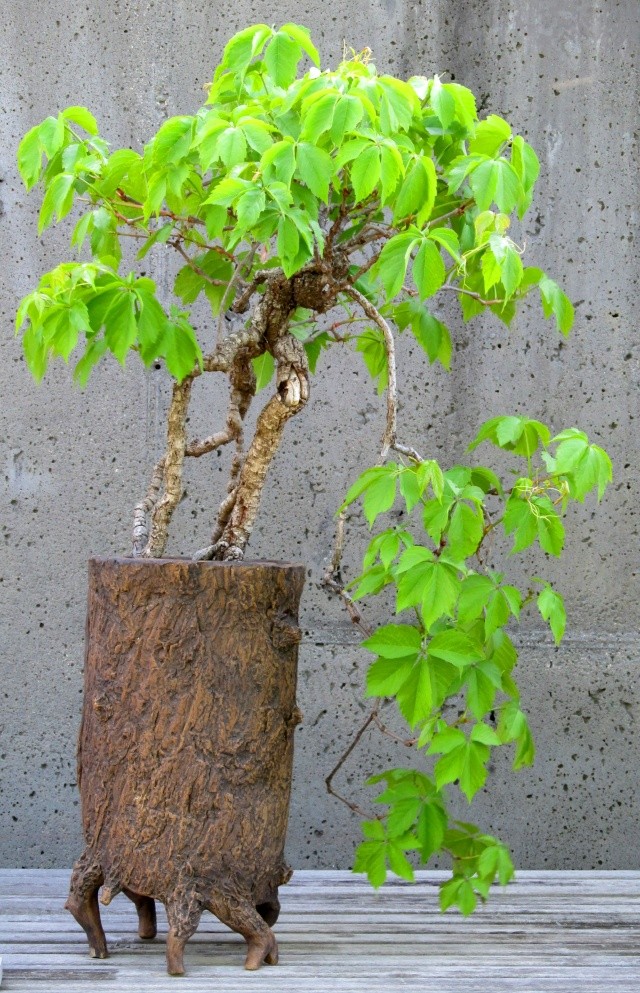
Virginia Creeper is a common vine in this part of the world, sometimes mistaken for Poison Ivy (Toxicodendron radicans) and usually regarded as a weed, which is why many people respond to it with a hoe or a dose of herbicide. While it is a vigorous grower that will freely volunteer to grow in a wide range of sites and conditions, it is a plant native to this region and not without attributes: it requires little or no care; it will grow in full sun or partial shade and is highly drought-tolerant; it can be pruned as much as you might like; its flowers are extremely attractive to a variety of bees; it has outstanding, deep red autumn color; and its blue fruits are a valuable wildlife food. In the right location, Virginia Creeper can be quite ornamental and used to good landscape effect. We have it in the bonsai garden, crawling up a rounded stone wall near the water feature (here seen in its autumn color phase, on the upper left):

Our Virginia Creeper bonsai came from my home landscape, where it had volunteered in an old abandoned raised garden bed. This bed had been built by the previous occupant of my house many years earlier and was already in dilapidated condition by the time my family and I moved into the place. The walls of the raised bed were 3 feet high and made of untreated pine. Over time the pine rotted and fell away, leaving a mound of earth that gradually eroded with years of rain. The roots of the Virginia Creeper were exposed as the soil line receded, and one day I looked at it and thought it might make an interesting exposed root, cascade form bonsai. I collected it one spring and planted it in a plastic pot. The next spring I moved it into a bonsai container and it was on display in the garden later that year. There are advantages to working with a tough, fast growing species!
The container currently employed for this bonsai is not the same one I originally used. A few years ago a friend from the Hinoki Bonsai Club in Roanoke, VA donated the unique container in question, saying she had purchased it from Dave Lowman at DaSu Bonsai Studios in Iowa, and never could figure out what to plant in it. I did not know what would work with it either, but one day it occurred to me that the Virginia Creeper might be the perfect choice - an unusual plant for an unusual container. Sometimes when I look at them in combination I think of the image as being that of an Ent, the anthropomorphic trees from the "Lord of the Rings". The legs on the container give the impression that this bonsai might walk away at any moment.
Here is a sequence showing the seasonal interest of this specimen, plus a closeup of the fruit:
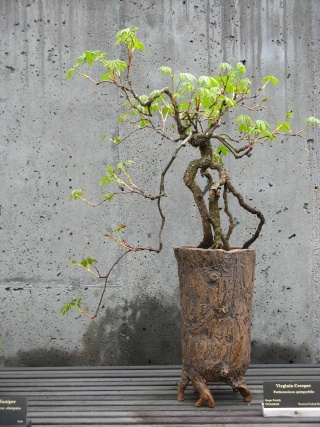

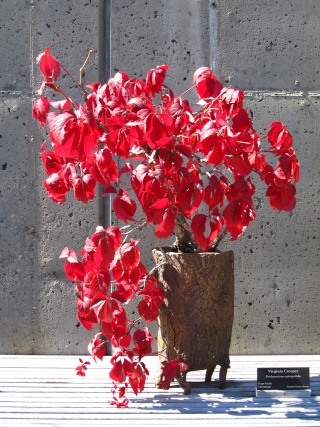
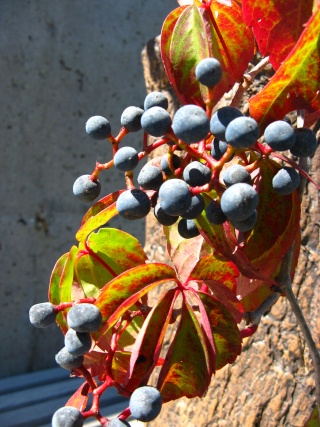
You may notice that I chose to lower the top of the bonsai this year, producing a more umbrella-like look to the upper line of the cascade:

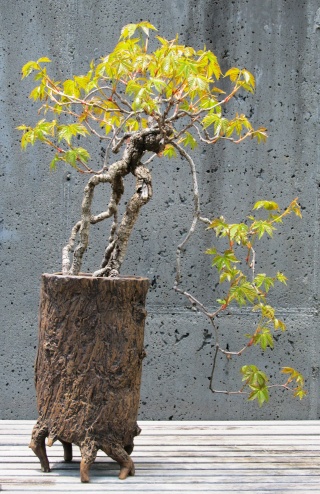
This decision was inspired by a wild plant I am familiar with in the mountains nearby. In this case, the plant actually is Poison Ivy, and it is a root-over-rock rather than exposed root form:
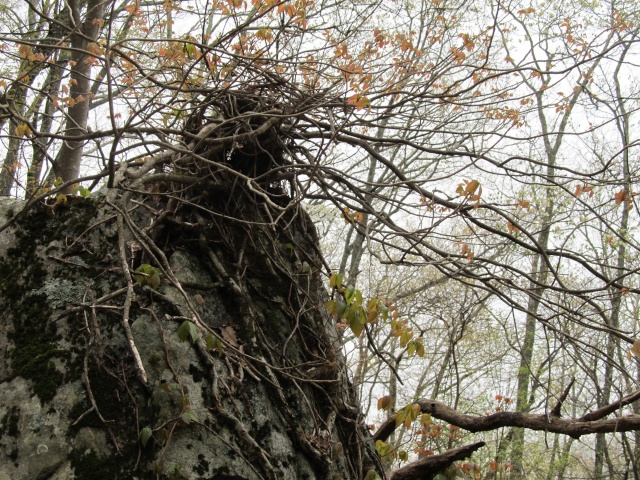
It is difficult to get a sense of scale from an image such as this. The spread of this plant, if measured side to side would be over 8 feet in length. The boulder it is growing on could easily crush a car.
--
The other day I was watering in the Bonsai Exhibition Garden when an older couple came along and engaged me in a conversation. Before long the woman asked something I frequently hear - "Which one is your favorite?" Because I think of that question as frivolous, little more than a pleasant attempt to express interest, I responded in a casual way - "Right now, my favorite is this one here". I nodded towards the bonsai I happened to be watering at the time. The couple looked, and when the woman read the label next to the plant she said, "Oh my goodness, I didn't know you could make a bonsai out of that - we kill that plant in our yard!" The man, silent to this point, grunted, "Is that a bonsai? Doesn't look very old to me..."
The bonsai we were looking at was this Virginia Creeper (Parthenocissus quinquefolia):

Virginia Creeper is a common vine in this part of the world, sometimes mistaken for Poison Ivy (Toxicodendron radicans) and usually regarded as a weed, which is why many people respond to it with a hoe or a dose of herbicide. While it is a vigorous grower that will freely volunteer to grow in a wide range of sites and conditions, it is a plant native to this region and not without attributes: it requires little or no care; it will grow in full sun or partial shade and is highly drought-tolerant; it can be pruned as much as you might like; its flowers are extremely attractive to a variety of bees; it has outstanding, deep red autumn color; and its blue fruits are a valuable wildlife food. In the right location, Virginia Creeper can be quite ornamental and used to good landscape effect. We have it in the bonsai garden, crawling up a rounded stone wall near the water feature (here seen in its autumn color phase, on the upper left):

Our Virginia Creeper bonsai came from my home landscape, where it had volunteered in an old abandoned raised garden bed. This bed had been built by the previous occupant of my house many years earlier and was already in dilapidated condition by the time my family and I moved into the place. The walls of the raised bed were 3 feet high and made of untreated pine. Over time the pine rotted and fell away, leaving a mound of earth that gradually eroded with years of rain. The roots of the Virginia Creeper were exposed as the soil line receded, and one day I looked at it and thought it might make an interesting exposed root, cascade form bonsai. I collected it one spring and planted it in a plastic pot. The next spring I moved it into a bonsai container and it was on display in the garden later that year. There are advantages to working with a tough, fast growing species!
The container currently employed for this bonsai is not the same one I originally used. A few years ago a friend from the Hinoki Bonsai Club in Roanoke, VA donated the unique container in question, saying she had purchased it from Dave Lowman at DaSu Bonsai Studios in Iowa, and never could figure out what to plant in it. I did not know what would work with it either, but one day it occurred to me that the Virginia Creeper might be the perfect choice - an unusual plant for an unusual container. Sometimes when I look at them in combination I think of the image as being that of an Ent, the anthropomorphic trees from the "Lord of the Rings". The legs on the container give the impression that this bonsai might walk away at any moment.
Here is a sequence showing the seasonal interest of this specimen, plus a closeup of the fruit:




You may notice that I chose to lower the top of the bonsai this year, producing a more umbrella-like look to the upper line of the cascade:


This decision was inspired by a wild plant I am familiar with in the mountains nearby. In this case, the plant actually is Poison Ivy, and it is a root-over-rock rather than exposed root form:

It is difficult to get a sense of scale from an image such as this. The spread of this plant, if measured side to side would be over 8 feet in length. The boulder it is growing on could easily crush a car.
--

Arthur Joura- Member
 Re: American Bonsai at the NC Arboretum
Re: American Bonsai at the NC Arboretum
Arthur Joura wrote:The man, silent to this point, grunted, "Is that a bonsai? Doesn't look very old to me..."
--
I love your posts Arthur. Keep them coming.
You can't leave us on a cliff hanger, what'd you say to the guy?
Have a great week!!!!
Sam
PS - I can hardly wait for the next Expo. I might show up a week early

Sam Ogranaja- Member
 Re: American Bonsai at the NC Arboretum
Re: American Bonsai at the NC Arboretum
Sam, thank you for reading and offering your supportive comments. I appreciate that you always bring a positive outlook to any conversation in which you partake.
In answer to your question - I did not respond to that man's remarks. Interacting with the public is a big part of my job, so much so that it would be difficult to say if I deal more with plants or with people. Sometimes I think I would rather spend all my time working with the plants, but the bonsai are only there for people to enjoy so I need the people to be there, too. It can be enjoyable talking with many of the visitors, and I have learned a lot from the questions they ask and the comments they make, but sometimes it is a challenge to maintain professional composure when dealing with certain members of the public. Admittedly, the difficulty sometimes has as much to do with me as it does with them! In all cases I try to take the proper read on the person in front of me, as well as on my own temperament at the moment. On that particular day, with that particular customer, it seemed best to let his comment pass.
This evening before I left to go home, I did a final walk-through of the Bonsai Exhibition Garden and was for some reason drawn to this landscape planting:
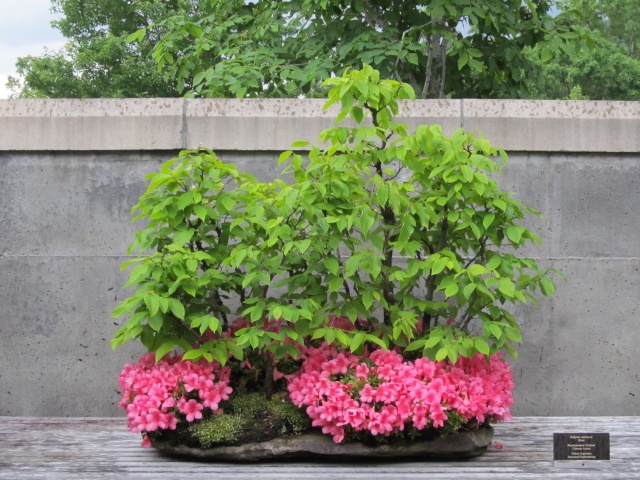
This piece is the work of my friends Ken Duncan and John Geanangel. The trees in the forest are American Hophornbeam (Ostrya virginiana) and the flowering plants in the understory are Chinzan Azaleas (Rhododendron X 'Chinzan').
In answer to your question - I did not respond to that man's remarks. Interacting with the public is a big part of my job, so much so that it would be difficult to say if I deal more with plants or with people. Sometimes I think I would rather spend all my time working with the plants, but the bonsai are only there for people to enjoy so I need the people to be there, too. It can be enjoyable talking with many of the visitors, and I have learned a lot from the questions they ask and the comments they make, but sometimes it is a challenge to maintain professional composure when dealing with certain members of the public. Admittedly, the difficulty sometimes has as much to do with me as it does with them! In all cases I try to take the proper read on the person in front of me, as well as on my own temperament at the moment. On that particular day, with that particular customer, it seemed best to let his comment pass.
This evening before I left to go home, I did a final walk-through of the Bonsai Exhibition Garden and was for some reason drawn to this landscape planting:

This piece is the work of my friends Ken Duncan and John Geanangel. The trees in the forest are American Hophornbeam (Ostrya virginiana) and the flowering plants in the understory are Chinzan Azaleas (Rhododendron X 'Chinzan').

Arthur Joura- Member
 "Yoshimura Island"
"Yoshimura Island"
A couple of Fridays back, I finally addressed a job that has been 18 years in the making. I have been wanting to post about it but have not been able to make the time to do so until now.
One of the signature pieces in the NC Arboretum bonsai collection is a unique, 17-tree group of American Hornbeam, planted on a slab of ... plywood. Here is a professionally made photograph of it from about 10 years ago:
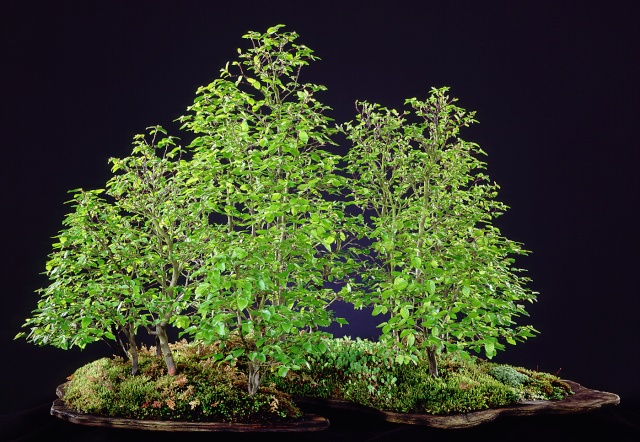
This tray landscape has been on display in the Bonsai Exhibition Garden every year since that facility first opened in October of 2005. It sits out in full sun all through the summer, and puts on an impressive display of autumn color almost every year:
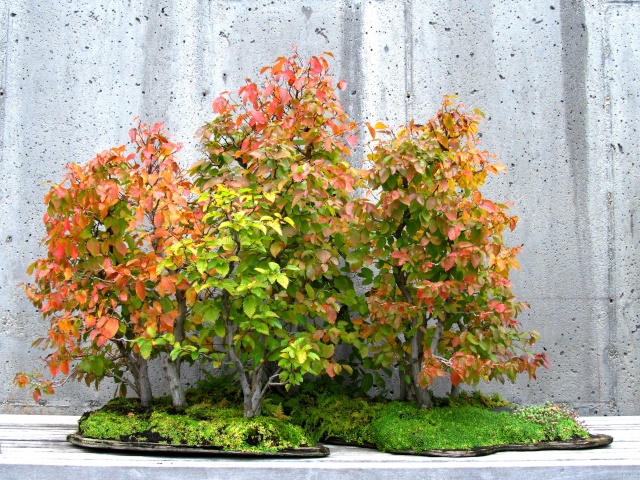
In January of 1995 I was able to spend a brief period of time studying with Yuji Yoshimura at his home in Briarcliff Manor, NY, a highly memorable experience I regard as the most influential of my bonsai career. On that trip I had taken with me 25 American Hornbeam (Carpinus caroliniana) trees in plastic nursery pots, 3 years from seed and completely untrained for bonsai use. On the final day of my stay Mr. Yoshimura used 17 of these trees to make a landscape planting. Along with the hornbeams, I had brought with me 2 different stoneware trays, quality Tokoname containers, one of which I anticipated would be used for the group. But Mr. Yoshimura had another idea. Scurrying to the back end of his dilapidated greenhouse, rummaging through a large and precarious pile of assorted stuff he pulled out an oddly shaped piece of plywood, announcing, "We will create masterpiece - ON WOOD!" I was dubious, never having seen a bonsai planting done on a piece of plywood. "Oh no" I said, hoping to dissuade him, "that's too nice - I'm sure you had something else planned for it!" Mr. Yoshimura had made up his mind, however, and it was not my place as the novice student to question the great teacher's decision.
Here is a picture of Mr. Yoshimura putting together the planting:
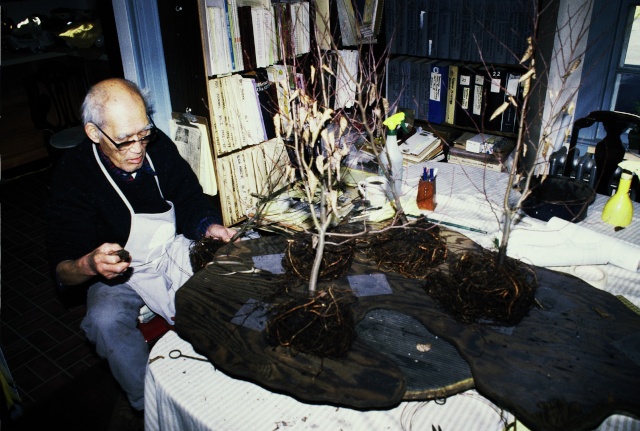
This photograph was taken at the Arboretum immediately upon my return there with the piece:
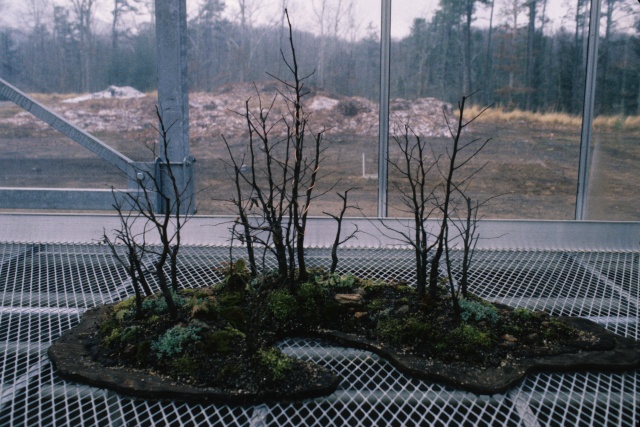
There is much, much more to this story, but it will wait for another time to be told. My purpose today is to document the work that was done to replace the original piece of plywood with a new one of the same design. When Mr. Yoshimura sent me home with his "masterpiece on wood", he told me "This slab will last for 10 years, then it will need to be replaced. But that will be your problem because by then I will be dead!" He was half right. Mr. Yoshimura was long gone by 2005, but the plywood was still completely solid. The original slab was made of marine plywood, treated with a copper-based preservative and then burnished with a torch. Only last year did the edges of the slab begin to get mushy with decay, after 18 years of use. Over that time, I had numerous people tell me that the planting was great but the plywood slab was no good. Several well intentioned friends offered to pay for an alternative, a similar slab made of stone or cement, or even a nice stoneware tray, anything but a piece of plywood! Early on I considered making such a change, but after awhile I came to think of the plywood slab as being a key component of the unique character of this tray landscape. It is inventively creative, and as such it well represents what made Mr. Yoshimura a great artist and a key figure in Western bonsai. I resolved that this iconic tray landscape - named "Yoshimura Island", by the way - will remain on a piece of plywood for as long as I have any say in the matter.
The following image sequence documents the process by which a new plywood slab was made and the group of hornbeams transferred to it. Captions describe what each picture shows. I was assisted in this work by my friend Charlie Dunnigan, long ago a member of the infamous "Secaucus 7" but since proven to be an upright citizen.
1) The outline of the slab's shape was drawn on the new sheet of pressure-treated plywood by tracing the contours and adding about an inch all around:
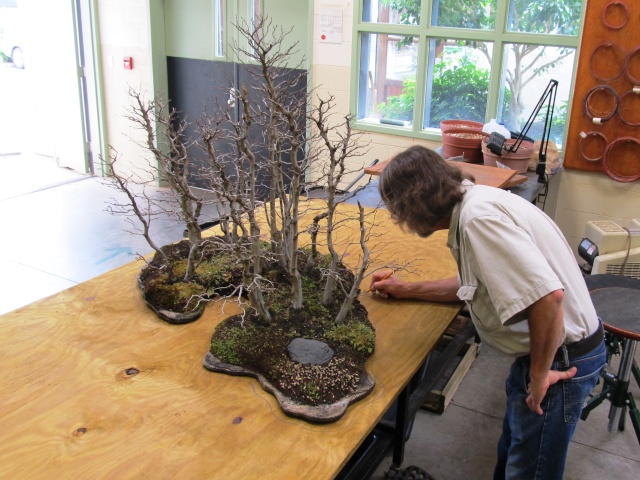
2) The shape was cut out using a sabre saw:
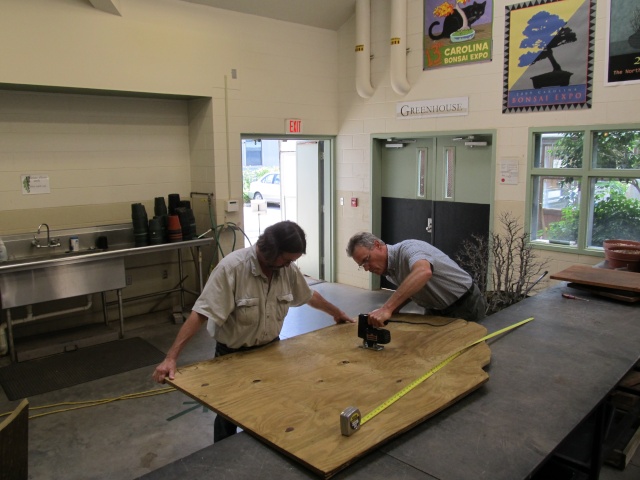
3) It looked like a big jigsaw puzzle:
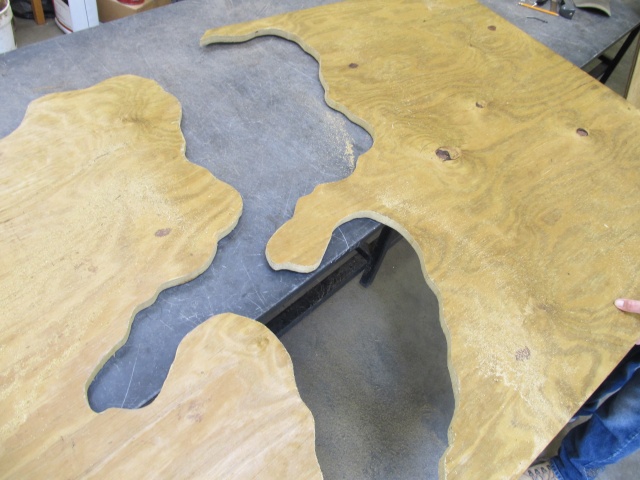
4) The edges of the slab's outline were rounded off, first with a die grinder with a router bit and then by hand with a wood rasp:
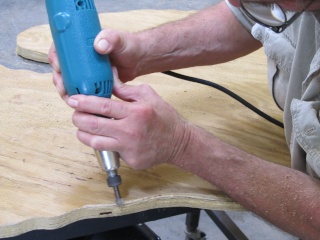
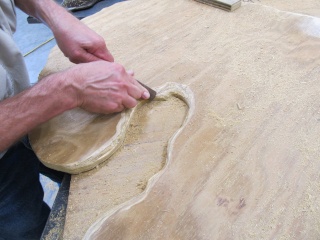
5) The cut out shape, with edges rounded off, was taken outside in preparation of burnishing with a propane torch (Mr. Yoshimura had done this on his original slab as a measure to further protect it against decay; for our purposes it also was intended to "cook" out any excess surface residue of the chemical used to preserve the pressure-treated plywood):
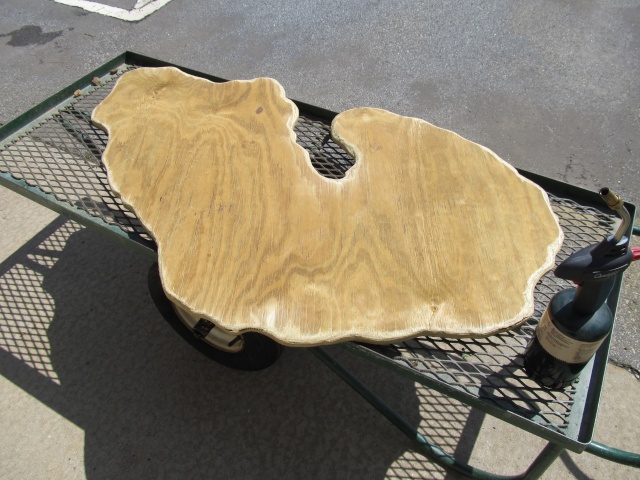
6) The burnishing highlighted the grain pattern of the wood, producing a tiger stripe effect which was an unanticipated but welcomed development:
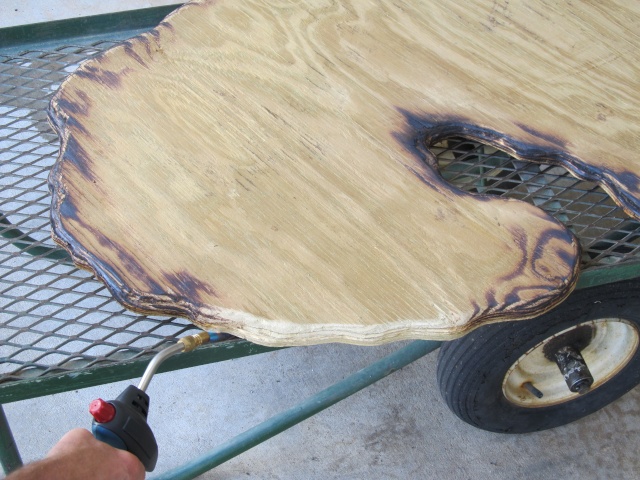
7) Drainage holes were drilled in the slab, and it was ready to receive the planting:
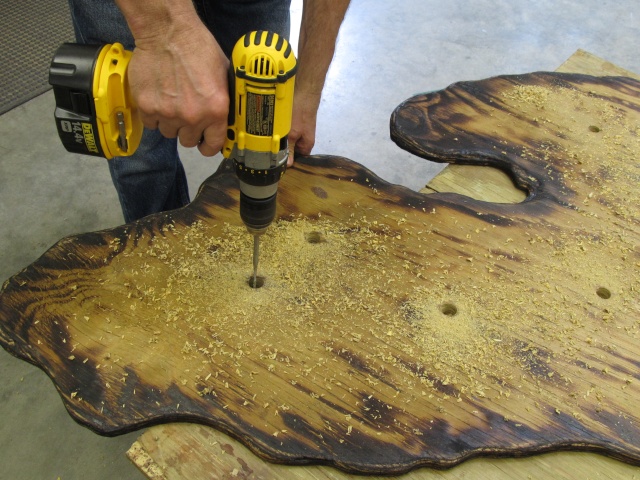
8) The roots of the hornbeams had attached themselves firmly to the decaying wood of the old slab and had to be pried off of it using a spade:
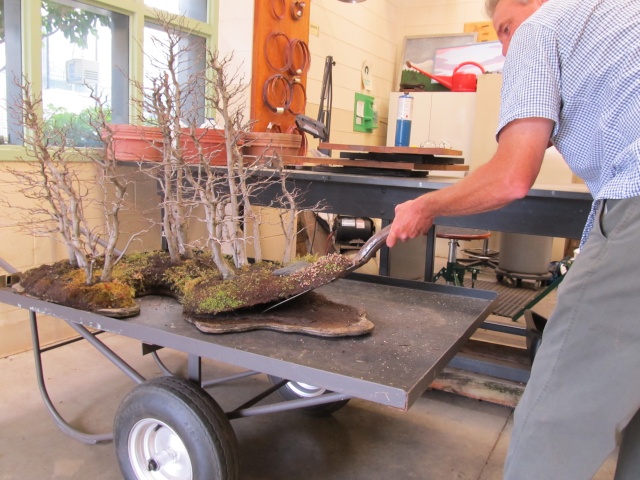
9) I had done root pruning on this planting 2 years ago, so decided to expedite the transplanting work by leaving the media mass undisturbed and moving it entire from the old slab to the new:
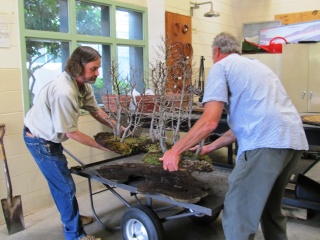
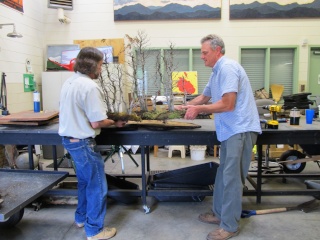
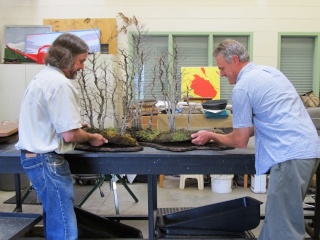
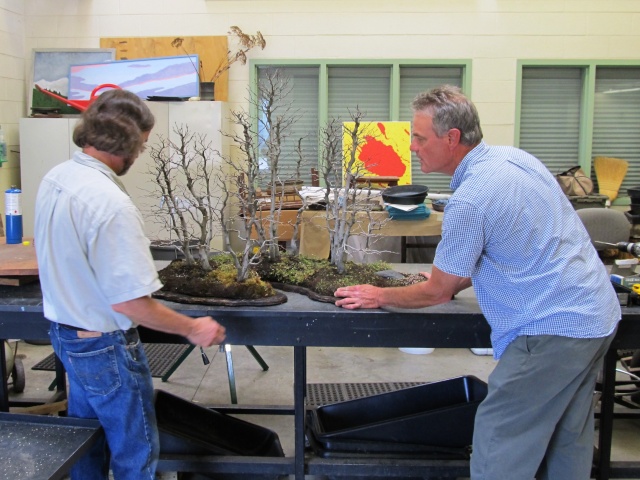
10) To keep the media mass in place we screwed it to the slab, using decking screws:
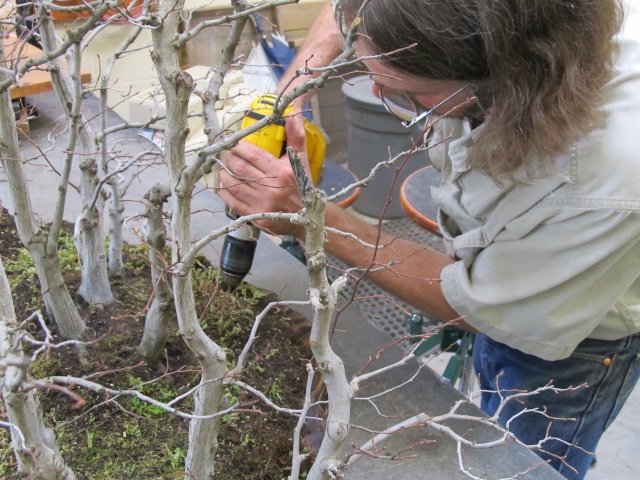
11) The planting successfully transferred to the new slab, sitting on a cart with the old slab posing alongside:
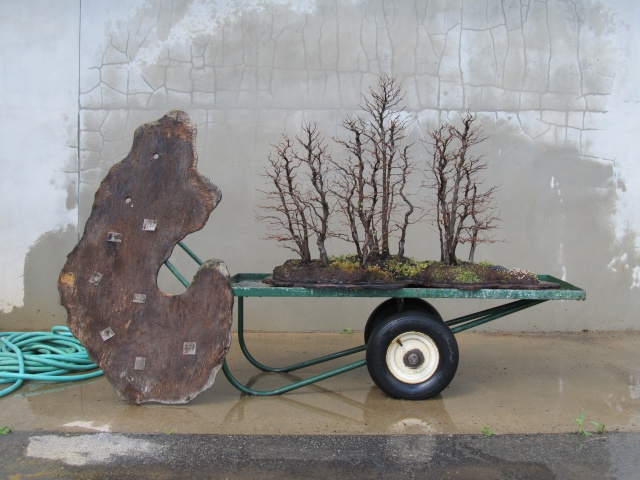
12) A detail of the tip of the "island", showing the black & brown grain pattern of the new slab:

Some of the more observant among you may have taken note of the fact that this work was done in mid-June yet the trees in the "Yoshimura Island" planting were without leaves. The Arboretum has a large, walk-in refrigerator in which I overwinter a portion of our bonsai collection, and this piece was kept in there waiting for me to make the new slab. I wanted to do the transfer of the planting while the trees were dormant, although it was not entirely necessary to do so. Once the planting was exposed to the warm late spring air it quickly broke bud and started to grow. Here it is today, 10 days after the work depicted in the pictures was done:
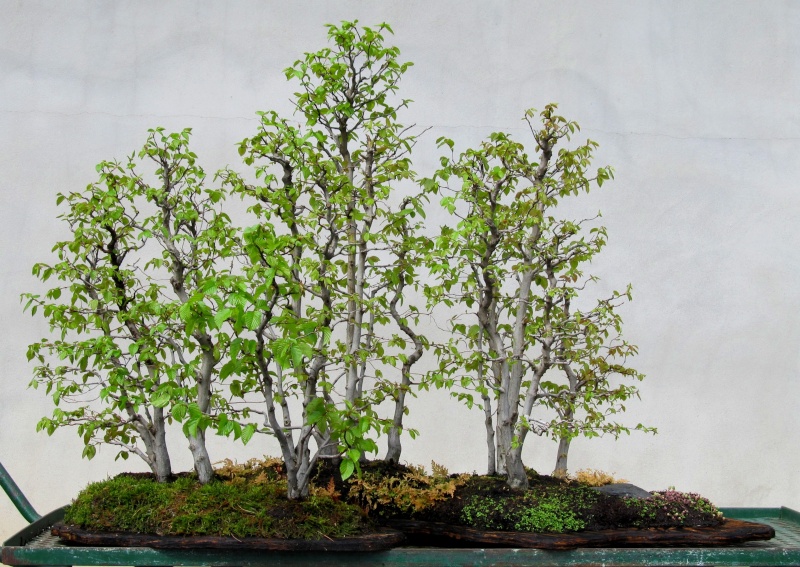
I do not know if this new slab will last as long as its predecessor. I used slightly thicker plywood this time, but the chemical treatment used today is different than what it was back when the original slab was made, and I have heard some claim that the new stuff does not hold up as well as the old. I also elected to forgo giving the slab an additional application of a copper-based preservative, as Mr. Yoshimura had done with his. It seemed to me that was a bit of overkill, but I suppose I will find out as the years go by. At any rate, if this current slab lasts for another 18 years, or even if it only makes it the 10 that Mr. Yoshimura thought his would, I should be covered. I expect it will be someone else's problem then, because I will be... retired (and hopefully not dead.)
--
One of the signature pieces in the NC Arboretum bonsai collection is a unique, 17-tree group of American Hornbeam, planted on a slab of ... plywood. Here is a professionally made photograph of it from about 10 years ago:

This tray landscape has been on display in the Bonsai Exhibition Garden every year since that facility first opened in October of 2005. It sits out in full sun all through the summer, and puts on an impressive display of autumn color almost every year:

In January of 1995 I was able to spend a brief period of time studying with Yuji Yoshimura at his home in Briarcliff Manor, NY, a highly memorable experience I regard as the most influential of my bonsai career. On that trip I had taken with me 25 American Hornbeam (Carpinus caroliniana) trees in plastic nursery pots, 3 years from seed and completely untrained for bonsai use. On the final day of my stay Mr. Yoshimura used 17 of these trees to make a landscape planting. Along with the hornbeams, I had brought with me 2 different stoneware trays, quality Tokoname containers, one of which I anticipated would be used for the group. But Mr. Yoshimura had another idea. Scurrying to the back end of his dilapidated greenhouse, rummaging through a large and precarious pile of assorted stuff he pulled out an oddly shaped piece of plywood, announcing, "We will create masterpiece - ON WOOD!" I was dubious, never having seen a bonsai planting done on a piece of plywood. "Oh no" I said, hoping to dissuade him, "that's too nice - I'm sure you had something else planned for it!" Mr. Yoshimura had made up his mind, however, and it was not my place as the novice student to question the great teacher's decision.
Here is a picture of Mr. Yoshimura putting together the planting:

This photograph was taken at the Arboretum immediately upon my return there with the piece:

There is much, much more to this story, but it will wait for another time to be told. My purpose today is to document the work that was done to replace the original piece of plywood with a new one of the same design. When Mr. Yoshimura sent me home with his "masterpiece on wood", he told me "This slab will last for 10 years, then it will need to be replaced. But that will be your problem because by then I will be dead!" He was half right. Mr. Yoshimura was long gone by 2005, but the plywood was still completely solid. The original slab was made of marine plywood, treated with a copper-based preservative and then burnished with a torch. Only last year did the edges of the slab begin to get mushy with decay, after 18 years of use. Over that time, I had numerous people tell me that the planting was great but the plywood slab was no good. Several well intentioned friends offered to pay for an alternative, a similar slab made of stone or cement, or even a nice stoneware tray, anything but a piece of plywood! Early on I considered making such a change, but after awhile I came to think of the plywood slab as being a key component of the unique character of this tray landscape. It is inventively creative, and as such it well represents what made Mr. Yoshimura a great artist and a key figure in Western bonsai. I resolved that this iconic tray landscape - named "Yoshimura Island", by the way - will remain on a piece of plywood for as long as I have any say in the matter.
The following image sequence documents the process by which a new plywood slab was made and the group of hornbeams transferred to it. Captions describe what each picture shows. I was assisted in this work by my friend Charlie Dunnigan, long ago a member of the infamous "Secaucus 7" but since proven to be an upright citizen.
1) The outline of the slab's shape was drawn on the new sheet of pressure-treated plywood by tracing the contours and adding about an inch all around:

2) The shape was cut out using a sabre saw:

3) It looked like a big jigsaw puzzle:

4) The edges of the slab's outline were rounded off, first with a die grinder with a router bit and then by hand with a wood rasp:


5) The cut out shape, with edges rounded off, was taken outside in preparation of burnishing with a propane torch (Mr. Yoshimura had done this on his original slab as a measure to further protect it against decay; for our purposes it also was intended to "cook" out any excess surface residue of the chemical used to preserve the pressure-treated plywood):

6) The burnishing highlighted the grain pattern of the wood, producing a tiger stripe effect which was an unanticipated but welcomed development:

7) Drainage holes were drilled in the slab, and it was ready to receive the planting:

8) The roots of the hornbeams had attached themselves firmly to the decaying wood of the old slab and had to be pried off of it using a spade:

9) I had done root pruning on this planting 2 years ago, so decided to expedite the transplanting work by leaving the media mass undisturbed and moving it entire from the old slab to the new:




10) To keep the media mass in place we screwed it to the slab, using decking screws:

11) The planting successfully transferred to the new slab, sitting on a cart with the old slab posing alongside:

12) A detail of the tip of the "island", showing the black & brown grain pattern of the new slab:

Some of the more observant among you may have taken note of the fact that this work was done in mid-June yet the trees in the "Yoshimura Island" planting were without leaves. The Arboretum has a large, walk-in refrigerator in which I overwinter a portion of our bonsai collection, and this piece was kept in there waiting for me to make the new slab. I wanted to do the transfer of the planting while the trees were dormant, although it was not entirely necessary to do so. Once the planting was exposed to the warm late spring air it quickly broke bud and started to grow. Here it is today, 10 days after the work depicted in the pictures was done:

I do not know if this new slab will last as long as its predecessor. I used slightly thicker plywood this time, but the chemical treatment used today is different than what it was back when the original slab was made, and I have heard some claim that the new stuff does not hold up as well as the old. I also elected to forgo giving the slab an additional application of a copper-based preservative, as Mr. Yoshimura had done with his. It seemed to me that was a bit of overkill, but I suppose I will find out as the years go by. At any rate, if this current slab lasts for another 18 years, or even if it only makes it the 10 that Mr. Yoshimura thought his would, I should be covered. I expect it will be someone else's problem then, because I will be... retired (and hopefully not dead.)
--
Last edited by Arthur Joura on Tue Jul 02, 2013 9:49 pm; edited 3 times in total

Arthur Joura- Member
 Re: American Bonsai at the NC Arboretum
Re: American Bonsai at the NC Arboretum
Wonderful photo essay Arthur. I appreciate all of the effort and the details that you are putting into your posts here.
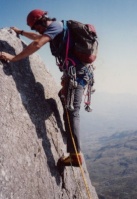
Kev Bailey- Admin
 Re: American Bonsai at the NC Arboretum
Re: American Bonsai at the NC Arboretum
This is a great thread, thanks for taking the tiem and sharing.
hometeamrocker- Member
 Summer Solstice
Summer Solstice
To lennard and hometeamrocker - My pleasure and thank you for reading!
To Kev - I appreciate having the IBC as a venue for posting, in addition to being a place to learn and see what others are doing. Thank you for making the site possible.
The Summer Solstice is tomorrow, and from that point forward the days begin to shorten. Strange to think that with the arrival of the first day of summer the clock on the growing season begins to slowly wind down. Here in this part of the world we have experienced an absolutely wonderful spring, cool and moist, and as a result everything is lush and green. Although I hear some people complaining about the abundant rain we have had so far this year, to me it is welcome relief from 8 years of drought out of the last 10. People who grow plants become sensitive to such things as rainfall and the changing seasons.
Here's an image to celebrate the Solstice:
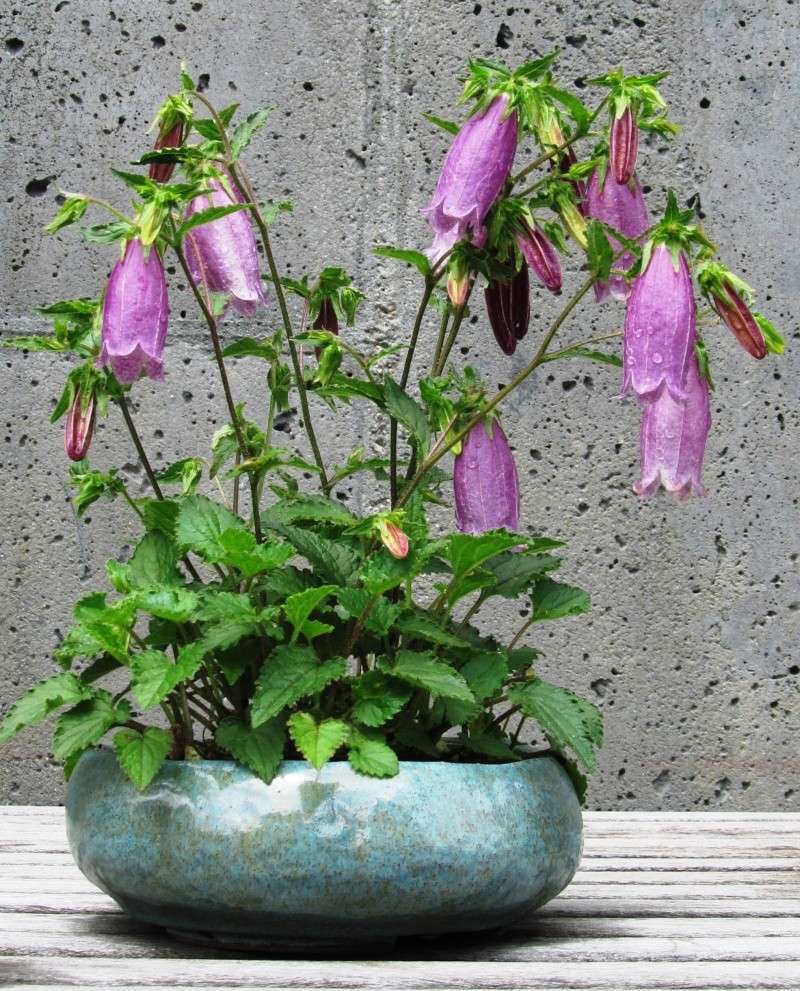
This plant was identified by the person who gave it to me as Bowl of Cherries Bellflower (Campanula punctata v. 'Bowl of Cherries'). It is a bellflower, no doubt, but the literature says 'Bowl of Cherries' has deep pink flowers. Looks more like a bowl of grapes to me. The container is by Dale Cochoy.
To Kev - I appreciate having the IBC as a venue for posting, in addition to being a place to learn and see what others are doing. Thank you for making the site possible.
The Summer Solstice is tomorrow, and from that point forward the days begin to shorten. Strange to think that with the arrival of the first day of summer the clock on the growing season begins to slowly wind down. Here in this part of the world we have experienced an absolutely wonderful spring, cool and moist, and as a result everything is lush and green. Although I hear some people complaining about the abundant rain we have had so far this year, to me it is welcome relief from 8 years of drought out of the last 10. People who grow plants become sensitive to such things as rainfall and the changing seasons.
Here's an image to celebrate the Solstice:

This plant was identified by the person who gave it to me as Bowl of Cherries Bellflower (Campanula punctata v. 'Bowl of Cherries'). It is a bellflower, no doubt, but the literature says 'Bowl of Cherries' has deep pink flowers. Looks more like a bowl of grapes to me. The container is by Dale Cochoy.

Arthur Joura- Member
 Re: American Bonsai at the NC Arboretum
Re: American Bonsai at the NC Arboretum
I first saw, and fell in love, with this plant in Japan. Like ballon flower, Platycodon, it's an important and much loved summer wildflower. It makes a great summer kusamono by itself or mixed with other grasses, displayed with an appropriate scroll. It's Japanese name is "hotaru bukuro", lightening bug-bag, and was a favorite of the children - along with rhinocerus beetles, the fruit of akebia vine and dragonflies - and of course lightening bugs.
Summertime in Japan... I'm so thankful my time there was way out in the countryside in a peaceful mountain valley. Sometimes I can still hear the cicadas... Meeem Meeem Meeem.....
Winter? Not so wonderful...
Summertime in Japan... I'm so thankful my time there was way out in the countryside in a peaceful mountain valley. Sometimes I can still hear the cicadas... Meeem Meeem Meeem.....
Winter? Not so wonderful...

Russell Coker- Member
 Re: American Bonsai at the NC Arboretum
Re: American Bonsai at the NC Arboretum
Arthur,
I've greatly enjoyed your posts and photos, your collection and arboretum are just charming. I love the history and stories that accompanied your trees. I realize that your career at the arboretum, even though seeming like paradise to many bonsai folk, was/is filled with much difficulty and backbreaking work.
I sat on Friday night and re-read the entire thread, unique and wonderful. I can't stop thinking about Mr. Yoshimura's forest planting on plywood. I'm glad you decided to place it on a new piece of plywood. Mr. Yoshimura certainly left his mark in our country.
The bonsai world is unique in that you get to communicate with many professional artists through forums, bonsai shows and seminars and email. I've found many of these people very happy to help the amateur and you're doing the same here.
Thanks very much.
Best regards,
Augustine
central MD 7a
I've greatly enjoyed your posts and photos, your collection and arboretum are just charming. I love the history and stories that accompanied your trees. I realize that your career at the arboretum, even though seeming like paradise to many bonsai folk, was/is filled with much difficulty and backbreaking work.
I sat on Friday night and re-read the entire thread, unique and wonderful. I can't stop thinking about Mr. Yoshimura's forest planting on plywood. I'm glad you decided to place it on a new piece of plywood. Mr. Yoshimura certainly left his mark in our country.
The bonsai world is unique in that you get to communicate with many professional artists through forums, bonsai shows and seminars and email. I've found many of these people very happy to help the amateur and you're doing the same here.
Thanks very much.
Best regards,
Augustine
central MD 7a
augustine- Member
 The View From Early July
The View From Early July
Russell - Thank you for sharing your reflections on summer in Japan! Not least among the many intriguing qualities of plants, they can be powerful triggers of memory, and even people who are not so aware of plants will respond to certain ones they associate with a particular person, time or place. A plant person such as yourself naturally tunes into this more acutely.
Here is another bellflower, grown from a division made of the one previously posted, planted in a container made by NC potter Sage Smith:
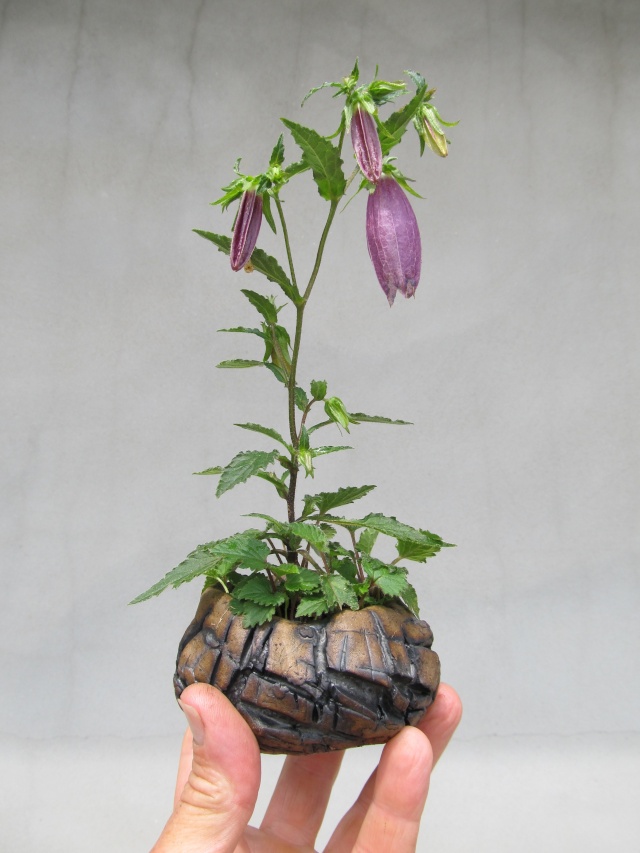
Augustine - Thank you for your kind comments! I appreciate that you take time to read what I write here, and if you and others find value in what I have to say it validates the effort it takes to write the words and post them. Your remarks regarding my work at the NC Arboretum prompt me to remember a bit of lyric from a song I used to listen to long ago: "If your work is not what you love, then something isn't right." Having worked for many years in a variety of jobs that were in turns physically abusive, mentally numbing and spiritually deadening, I am glad to be in a place now where I have reason to be grateful every day.
And I am grateful, but also ridiculously busy throughout the growing season and often worn down by my inability to keep up with everything that wants doing. Maintaining this thread is one more task that takes time and attention, and lately has been shortchanged. Here then, to keep my hand in, are some images made just yesterday in the garden:
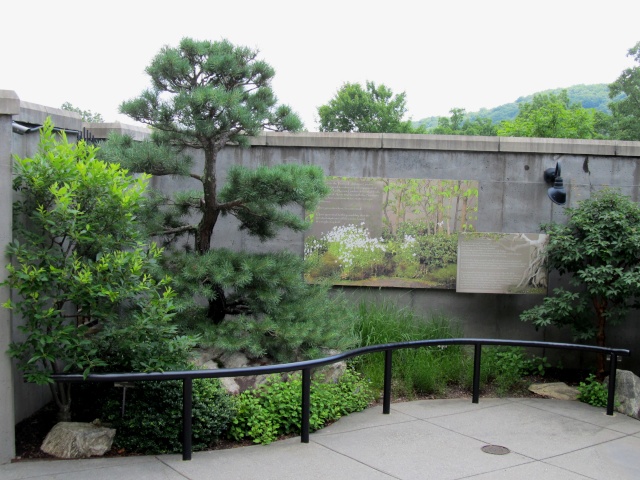
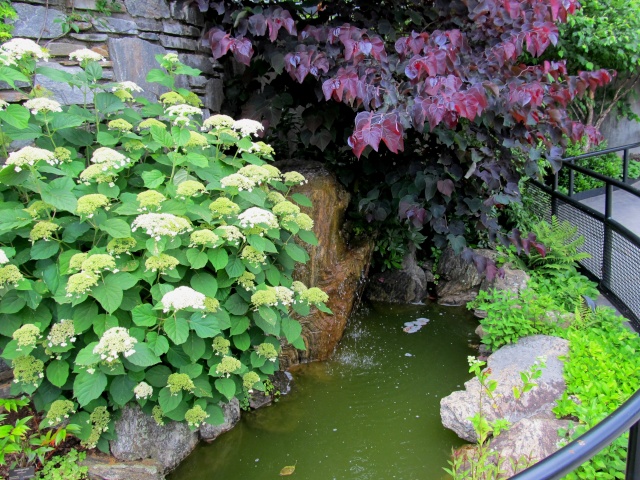
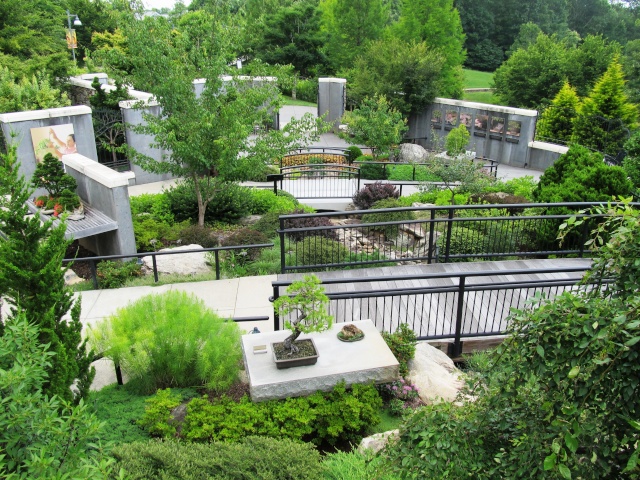
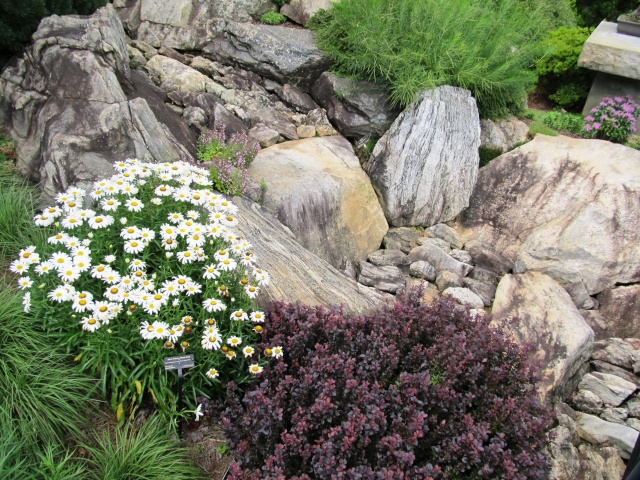
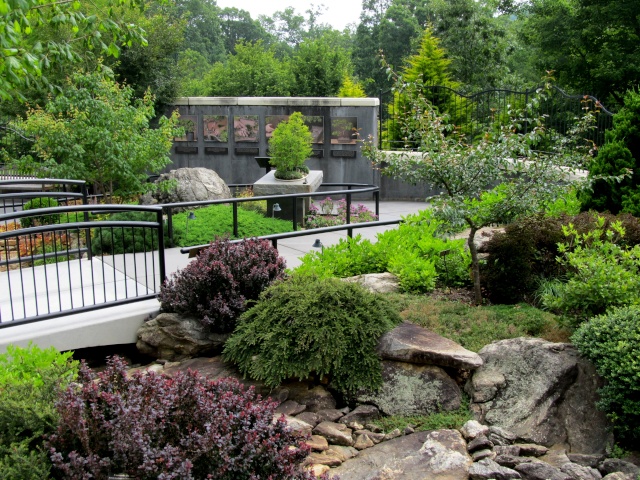
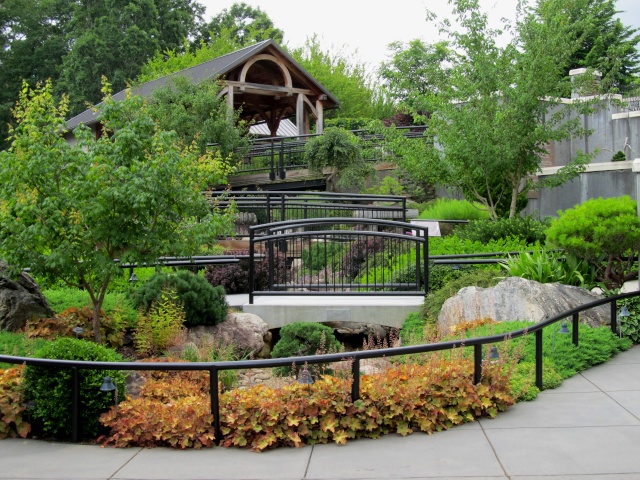
The good rain we enjoyed this spring is so far continuing on into summer. I cannot remember ever seeing the plants, be they in the forest, or the cultivated landscape, or in decorative little pots, looking so full and lush. When I read about wildfires raging in parts of the country sucked dry by drought I give thanks for the blessing of water falling from the sky.
The bonsai images that follow were also made yesterday in the garden.
From left to right - Blue Atlas Cedar (Cedrus atlantica 'Glauca'); Trident Maple (Acer buergerianum); Bowl of Cherries Bellflower (Campanula punctata v. 'Bowl of Cherries'); Eastern White Pine (Pinus strobus):
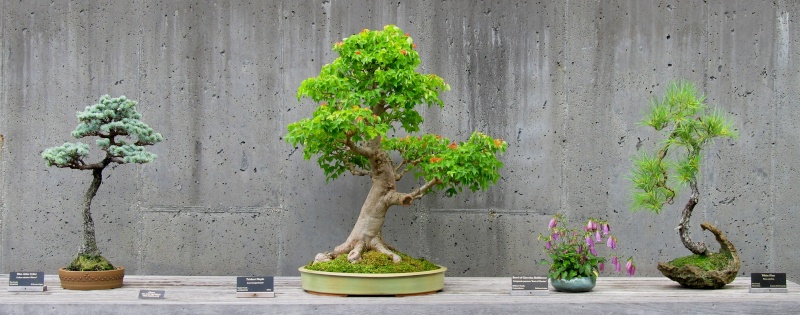
The "Chase Grove" landscape planting, featuring Dwarf Hinoki Falsecypress (Chamaecyparis obtusa 'Nana Gracilis') and Chinzan Azalea (Rhododendron x 'Chinzan'), originally created by Chase Rosade in a demonstration in Washington, DC in 1996:
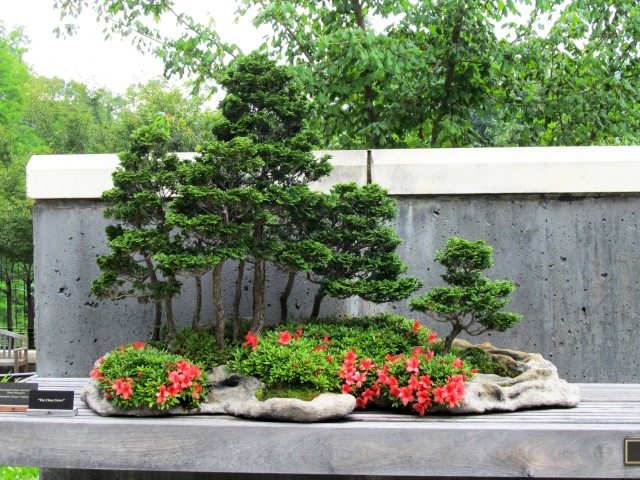
And finally, a planting of Mountain Dandelion (Krigia montana), a wildflower native to the higher elevations of the Southern Appalachian Mountains:
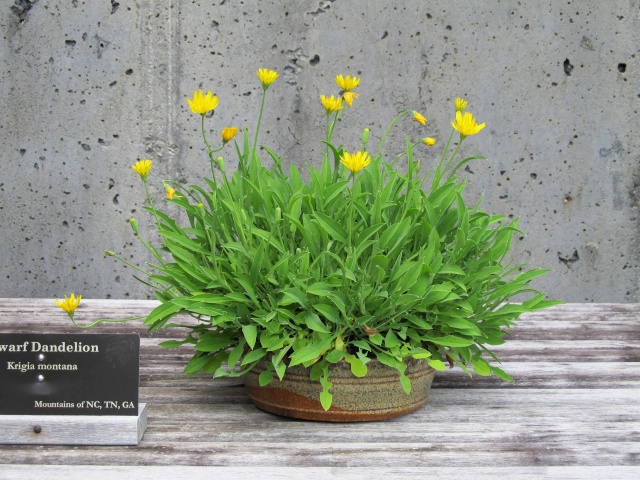
Here is another bellflower, grown from a division made of the one previously posted, planted in a container made by NC potter Sage Smith:

Augustine - Thank you for your kind comments! I appreciate that you take time to read what I write here, and if you and others find value in what I have to say it validates the effort it takes to write the words and post them. Your remarks regarding my work at the NC Arboretum prompt me to remember a bit of lyric from a song I used to listen to long ago: "If your work is not what you love, then something isn't right." Having worked for many years in a variety of jobs that were in turns physically abusive, mentally numbing and spiritually deadening, I am glad to be in a place now where I have reason to be grateful every day.
And I am grateful, but also ridiculously busy throughout the growing season and often worn down by my inability to keep up with everything that wants doing. Maintaining this thread is one more task that takes time and attention, and lately has been shortchanged. Here then, to keep my hand in, are some images made just yesterday in the garden:






The good rain we enjoyed this spring is so far continuing on into summer. I cannot remember ever seeing the plants, be they in the forest, or the cultivated landscape, or in decorative little pots, looking so full and lush. When I read about wildfires raging in parts of the country sucked dry by drought I give thanks for the blessing of water falling from the sky.
The bonsai images that follow were also made yesterday in the garden.
From left to right - Blue Atlas Cedar (Cedrus atlantica 'Glauca'); Trident Maple (Acer buergerianum); Bowl of Cherries Bellflower (Campanula punctata v. 'Bowl of Cherries'); Eastern White Pine (Pinus strobus):

The "Chase Grove" landscape planting, featuring Dwarf Hinoki Falsecypress (Chamaecyparis obtusa 'Nana Gracilis') and Chinzan Azalea (Rhododendron x 'Chinzan'), originally created by Chase Rosade in a demonstration in Washington, DC in 1996:

And finally, a planting of Mountain Dandelion (Krigia montana), a wildflower native to the higher elevations of the Southern Appalachian Mountains:


Arthur Joura- Member
 Re: American Bonsai at the NC Arboretum
Re: American Bonsai at the NC Arboretum
I'm very grateful that you can find time to post here Arthur and enjoy them immensely. Also sympathetic for the many in the US who are suffering drought and fire. I hope it rains for you soon.

Kev Bailey- Admin
 Re: American Bonsai at the NC Arboretum
Re: American Bonsai at the NC Arboretum
Once again, thanks, Arthur. That white pine is one of my new favorites. It is a very unusual species for bonsai, and I've use a picture of that tree to encourage people to try working with it.
On drought, heat. and fire, 19 firefighters died in Arizona last weekend when a blaze reversed course and flared over them. That happened just a few miles from where I used to visit my mother. Everything is so dry there, and 115+ degree temperatures aren't helping.
On drought, heat. and fire, 19 firefighters died in Arizona last weekend when a blaze reversed course and flared over them. That happened just a few miles from where I used to visit my mother. Everything is so dry there, and 115+ degree temperatures aren't helping.
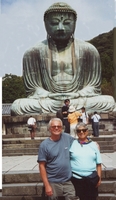
JimLewis- Member
 Re: American Bonsai at the NC Arboretum
Re: American Bonsai at the NC Arboretum
Really enjoy your posts Arthur. I absolutely love that Chase Grove.
Mike
Mike
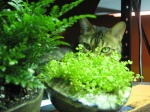
MikeG- Member
 Re: American Bonsai at the NC Arboretum
Re: American Bonsai at the NC Arboretum
Knowing just how busy you are makes reading your posts that much more enjoyable. Chase Rosade's Grove is AMAZING!!!! The azaleas add lots of character and depth to the planting as well as a perfect splash of color.
Thanks for keeping up with your posts here!!!
I hope you'll continue to do so.
Have a great 4th everyone!!!
Sam
PS - On pins and needles for the Expo this year. Can't wait.
Thanks for keeping up with your posts here!!!
I hope you'll continue to do so.
Have a great 4th everyone!!!
Sam
PS - On pins and needles for the Expo this year. Can't wait.

Sam Ogranaja- Member
 Re: American Bonsai at the NC Arboretum
Re: American Bonsai at the NC Arboretum
Arthur, I really like your posts and would love to visit the gardens someday. I have a question for you re: a quote I copied from one of your posts a while back.
"And finally, because we go to great lengths to avoid using pesticides in the Bonsai Exhibition Garden, it is a place teeming with all sorts of life. The 3 pictures that follow I think of as "the birds & the bees (& the skinks)".
If you have a few minutes someday to share some of the measures you use I would be very interested to hear about them. I am not a fan of the squish every bug you see then spray poison on it approach to bonsai cultivation.
Thanks, keep up the good work
Monte
"And finally, because we go to great lengths to avoid using pesticides in the Bonsai Exhibition Garden, it is a place teeming with all sorts of life. The 3 pictures that follow I think of as "the birds & the bees (& the skinks)".
If you have a few minutes someday to share some of the measures you use I would be very interested to hear about them. I am not a fan of the squish every bug you see then spray poison on it approach to bonsai cultivation.
Thanks, keep up the good work
Monte
monte- Member
 "The Chase Grove" tray landscape
"The Chase Grove" tray landscape
Kev, Jim and Sam - Thank you for your comments and continuing support! I would like to post more and hopefully when things slow down a bit (about late October) I will.
Mike - Thanks for reading and commenting. If we ever did a poll of the public's choice for the favorite piece in the NC Arboretum's bonsai collection, "The Chase Grove" would probably win. Everyone seems to like it and relate to it in some way.
As I mentioned, it was made by Chase Rosade in a demonstration at a convention back in the mid-90's, and it was purchased at auction that same weekend by a man from Rock Hill, South Carolina. That man did not have a way to get the large planting home with him at the end of the convention, so he asked Chase to bring it back to his nursery in Pennsylvania and hold it until arrangements could be made to transport it to SC. For whatever reason, those arrangements were never made. After more than a year of waiting, Chase called the man to tell him he could not hold the piece forever, and the man from Rock Hill then decided the planting was too large for him anyway and offered it to the Arboretum. As it happened, Chase was about to make a trip out to Mississippi, to Brussel's Nursery, and offered to haul the planting part of the way south to a prearranged meeting place and pass it off to me. That's how it came to be that one gray afternoon I drove out to the I-40 welcome center in East Tennessee, met up with Chase and his traveling partner, Jim Doyle, and transferred the more than 5' long planting from their van to mine. I did not really know Jim at that point and Chase was annoyed because I was late and kept them waiting there awhile, so we did not stick around to talk much. It took just a few minutes and then we drove off in our separate directions. It was kind of like an illicit contraband deal, only without the risk of going to prison.
Anyway, as soon as I got back to the Arboretum I made a photograph of the piece:
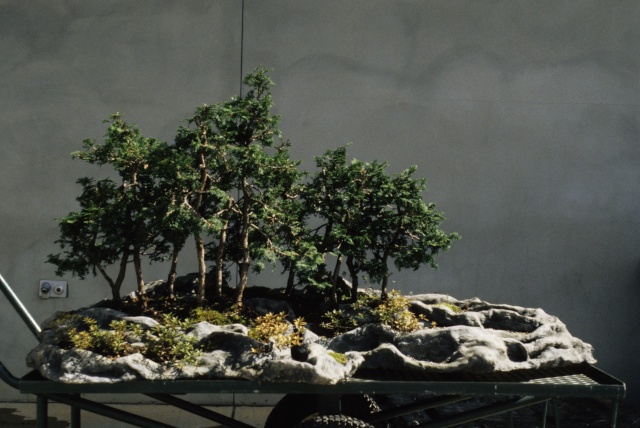
I think a big part of the appeal of this piece is in the gargantuan fabricated slab. Chase Rosade made that, too, using a technique not unlike that employed by people who make mountain scenery for a model railroad layout. He started with a wooden armature, which was then covered with hardware cloth (metal screening), which was then manipulated to form the contours and undulations of the "rock". Over that went strips of fiberglass cloth, like that used in auto body repair, which was first soaked in a slurry of Ciment Fondu. Lastly, the exterior was covered with a thin coat of Ciment Fondu applied with a paint brush. So, the slab is hollow and fortunately a lot lighter than it appears to be. I think Chase has made many such planters over the years, but this might have been one of his first on such a large scale. It is a neat idea, although the surface is a bit fragile, requiring minor repairs over time.
12 years went by before I needed to repot the planting. In this picture, made in June of 2009, you can see that all the plants have grown and filled out considerably:
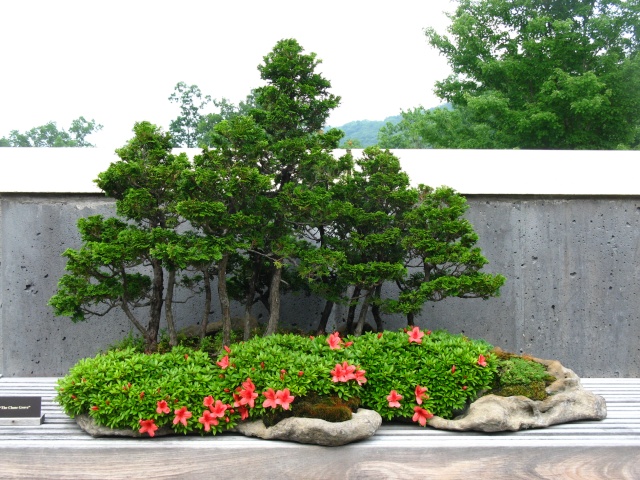
It was necessary to take out plant material, both azalea and falsecypress, to alleviate overcrowding. This meant some alteration of the original design, but I tried to put it back together in a way that respected the feel of Chase's work. Here is how it looked in autumn of 2010, one growing season after the replanting occurred:

The plants responded favorably to being repotted. Here is a photograph from autumn of 2011, one year after the picture above was made, wherein you can see how the process of the landscape filling out is once more underway:

Finally, for the sake of easy comparison, here is the image of "The Chase Grove" that appeared in my previous post, showing it as it appeared in flower a few weeks ago:
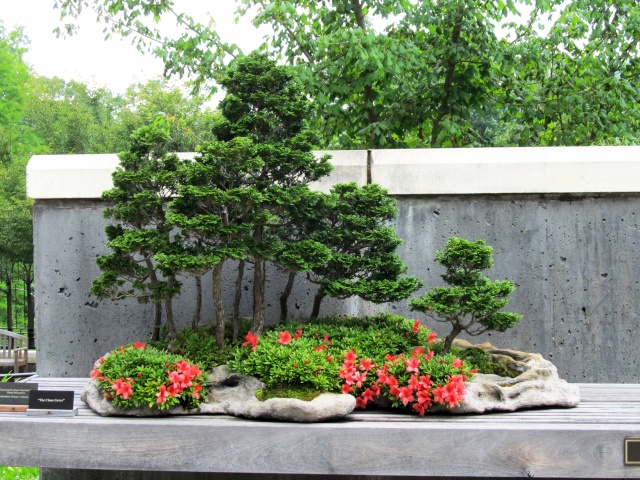
I named this planting in Chase's honor because he is one of the more important and influential figures in American bonsai, and we are proud to have a piece of his work in our collection. He is a genuinely likable guy, too.
Monte - I did not overlook your comment. I appreciate your interest in the pest management practices we employ at the Arboretum and intend to respond to your question. However, I am out of time right now. My next post will be on that subject. Thank you for reading!
Mike - Thanks for reading and commenting. If we ever did a poll of the public's choice for the favorite piece in the NC Arboretum's bonsai collection, "The Chase Grove" would probably win. Everyone seems to like it and relate to it in some way.
As I mentioned, it was made by Chase Rosade in a demonstration at a convention back in the mid-90's, and it was purchased at auction that same weekend by a man from Rock Hill, South Carolina. That man did not have a way to get the large planting home with him at the end of the convention, so he asked Chase to bring it back to his nursery in Pennsylvania and hold it until arrangements could be made to transport it to SC. For whatever reason, those arrangements were never made. After more than a year of waiting, Chase called the man to tell him he could not hold the piece forever, and the man from Rock Hill then decided the planting was too large for him anyway and offered it to the Arboretum. As it happened, Chase was about to make a trip out to Mississippi, to Brussel's Nursery, and offered to haul the planting part of the way south to a prearranged meeting place and pass it off to me. That's how it came to be that one gray afternoon I drove out to the I-40 welcome center in East Tennessee, met up with Chase and his traveling partner, Jim Doyle, and transferred the more than 5' long planting from their van to mine. I did not really know Jim at that point and Chase was annoyed because I was late and kept them waiting there awhile, so we did not stick around to talk much. It took just a few minutes and then we drove off in our separate directions. It was kind of like an illicit contraband deal, only without the risk of going to prison.
Anyway, as soon as I got back to the Arboretum I made a photograph of the piece:

I think a big part of the appeal of this piece is in the gargantuan fabricated slab. Chase Rosade made that, too, using a technique not unlike that employed by people who make mountain scenery for a model railroad layout. He started with a wooden armature, which was then covered with hardware cloth (metal screening), which was then manipulated to form the contours and undulations of the "rock". Over that went strips of fiberglass cloth, like that used in auto body repair, which was first soaked in a slurry of Ciment Fondu. Lastly, the exterior was covered with a thin coat of Ciment Fondu applied with a paint brush. So, the slab is hollow and fortunately a lot lighter than it appears to be. I think Chase has made many such planters over the years, but this might have been one of his first on such a large scale. It is a neat idea, although the surface is a bit fragile, requiring minor repairs over time.
12 years went by before I needed to repot the planting. In this picture, made in June of 2009, you can see that all the plants have grown and filled out considerably:

It was necessary to take out plant material, both azalea and falsecypress, to alleviate overcrowding. This meant some alteration of the original design, but I tried to put it back together in a way that respected the feel of Chase's work. Here is how it looked in autumn of 2010, one growing season after the replanting occurred:

The plants responded favorably to being repotted. Here is a photograph from autumn of 2011, one year after the picture above was made, wherein you can see how the process of the landscape filling out is once more underway:

Finally, for the sake of easy comparison, here is the image of "The Chase Grove" that appeared in my previous post, showing it as it appeared in flower a few weeks ago:

I named this planting in Chase's honor because he is one of the more important and influential figures in American bonsai, and we are proud to have a piece of his work in our collection. He is a genuinely likable guy, too.
Monte - I did not overlook your comment. I appreciate your interest in the pest management practices we employ at the Arboretum and intend to respond to your question. However, I am out of time right now. My next post will be on that subject. Thank you for reading!
Last edited by Arthur Joura on Fri Aug 02, 2013 6:48 am; edited 1 time in total

Arthur Joura- Member
 Re: American Bonsai at the NC Arboretum
Re: American Bonsai at the NC Arboretum
Thanks Arthur, looking forward to it, whenever you have some time of course. I enjoyed the story of the grove too, thanks.
Monte
Monte
monte- Member
 Integrated Pest Management (part 1)
Integrated Pest Management (part 1)
Try this: Find an insect or bug, something large would be best, perhaps one of these:
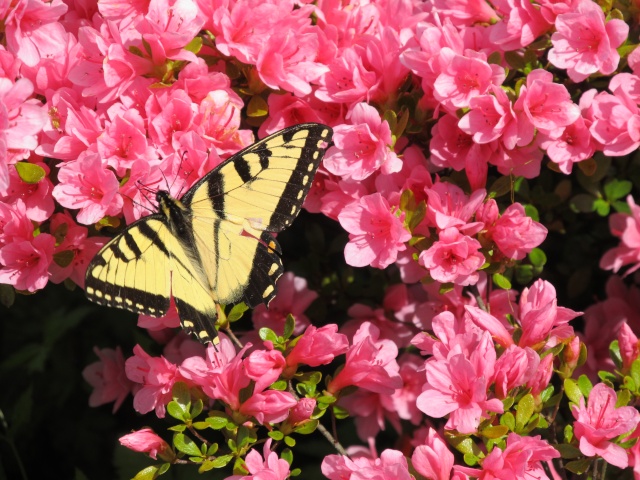
Now, tear off its wings. Take off its legs and antennae, too. Now lay it out in the sun on a hot sidewalk and watch it. It squirms and its mouth parts move. The creature is in agony. It probably will not make any noise, or at least none that our ears can hear, but if it could it would be screaming.
Of course you would not do such a cruel, barbaric thing and neither would I, but I do spray insecticides. You probably use them too, to protect yourself, or your pets, or your house, or your plants. Insecticides kill insects and bugs, usually by attacking their nervous system although sometimes they kill by suffocation or dessication, or inducing paralysis, or inhibiting energy production, or causing the creature to stop eating and so starve to death. The end result is death, though, and the route there is usually slow and torturous. How is it better to kill with insecticides as opposed to physically torturing an insect to death? If you are like me, you justify your use of these chemicals by describing the creatures you kill as being "bad bugs". Most people would include the following as "bad bugs": Fleas, ticks, mosquitoes, flies and cockroaches. People who enjoy growing plants will probably expand the list to include aphids, whitefly, thrips, spider mites and mealybugs. How about caterpillars? They eat leaves and can do a lot of damage to crops and ornamental plants, so they must be "bad bugs". But some of them turn into butterflies... And how about spiders? Most people seem to think of spiders as bad and will kill them, largely out of fear, but spiders eat other insects and so might be thought of as "good bugs".
It gets complicated, because it is complicated. Life is an unimaginably huge and complex system, in which all the parts are somehow interwoven. So much is still unknown to us. A great deal of brilliant science has gone into the formulation of modern insecticides and still they are blunt instruments, especially in the way they are so often misused. When I started out in horticulture I was shocked to learn how drenched the whole business is in pesticides, and how accepted their use is. I was repelled by this, and yet over time I came to be more accepting of it, and now looking back I realize that I have killed literally millions of living creatures, and did so with intent. I cannot make excuses for this behavior. I made a rational choice: I grow plants for a living, so I have to protect the plants I grow. Insects that eat plants are my enemy, so I destroy them.
Still, I think of myself as one who loves nature, and so this wanton destruction of certain parts of it I deem undesirable does not sit comfortably with me. I still do it - I sprayed fungicide on Tuesday, horticultural oil on Thursday and herbicide today - but I work to remain conscious of what I am doing and to do it as responsibly as I can. I have made the choice to kill certain things, but I try to be both intelligent and sensitive in the way I go about it. This is a horribly compromised position to be in, but when I look around me it seems that being horribly compromised is part of the human condition.
In my work at the Arboretum, I strive to practice what is referred to as Integrated Pest Management. Here is a definition from the web site of the US Environmental Protection Agency http://www.epa.gov/opp00001/factsheets/ipm.htm:
"Integrated Pest Management (IPM) is an effective and environmentally sensitive approach to pest management that relies on a combination of common-sense practices. IPM programs use current, comprehensive information on the life cycles of pests and their interaction with the environment. This information, in combination with available pest control methods, is used to manage pest damage by the most economical means, and with the least possible hazard to people, property, and the environment.
The IPM approach can be applied to both agricultural and non-agricultural settings, such as the home, garden, and workplace. IPM takes advantage of all appropriate pest management options including, but not limited to, the judicious use of pesticides. In contrast, organic food production applies many of the same concepts as IPM but limits the use of pesticides to those that are produced from natural sources, as opposed to synthetic chemicals."
A big part of my personal approach is to begin by thinking of the Bonsai Exhibition Garden, and the bonsai displayed within it, as being a tiny piece of the natural world. The walls that contain the garden do not exclude it from greater nature, just as the pot that holds the bonsai does not exclude that plant from greater nature. I have to be careful what I do with the garden and with the bonsai because they are connected to everything else in nature.
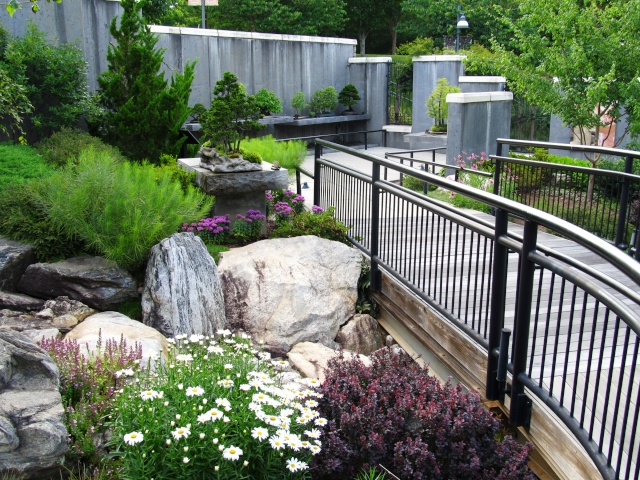

Now, tear off its wings. Take off its legs and antennae, too. Now lay it out in the sun on a hot sidewalk and watch it. It squirms and its mouth parts move. The creature is in agony. It probably will not make any noise, or at least none that our ears can hear, but if it could it would be screaming.
Of course you would not do such a cruel, barbaric thing and neither would I, but I do spray insecticides. You probably use them too, to protect yourself, or your pets, or your house, or your plants. Insecticides kill insects and bugs, usually by attacking their nervous system although sometimes they kill by suffocation or dessication, or inducing paralysis, or inhibiting energy production, or causing the creature to stop eating and so starve to death. The end result is death, though, and the route there is usually slow and torturous. How is it better to kill with insecticides as opposed to physically torturing an insect to death? If you are like me, you justify your use of these chemicals by describing the creatures you kill as being "bad bugs". Most people would include the following as "bad bugs": Fleas, ticks, mosquitoes, flies and cockroaches. People who enjoy growing plants will probably expand the list to include aphids, whitefly, thrips, spider mites and mealybugs. How about caterpillars? They eat leaves and can do a lot of damage to crops and ornamental plants, so they must be "bad bugs". But some of them turn into butterflies... And how about spiders? Most people seem to think of spiders as bad and will kill them, largely out of fear, but spiders eat other insects and so might be thought of as "good bugs".
It gets complicated, because it is complicated. Life is an unimaginably huge and complex system, in which all the parts are somehow interwoven. So much is still unknown to us. A great deal of brilliant science has gone into the formulation of modern insecticides and still they are blunt instruments, especially in the way they are so often misused. When I started out in horticulture I was shocked to learn how drenched the whole business is in pesticides, and how accepted their use is. I was repelled by this, and yet over time I came to be more accepting of it, and now looking back I realize that I have killed literally millions of living creatures, and did so with intent. I cannot make excuses for this behavior. I made a rational choice: I grow plants for a living, so I have to protect the plants I grow. Insects that eat plants are my enemy, so I destroy them.
Still, I think of myself as one who loves nature, and so this wanton destruction of certain parts of it I deem undesirable does not sit comfortably with me. I still do it - I sprayed fungicide on Tuesday, horticultural oil on Thursday and herbicide today - but I work to remain conscious of what I am doing and to do it as responsibly as I can. I have made the choice to kill certain things, but I try to be both intelligent and sensitive in the way I go about it. This is a horribly compromised position to be in, but when I look around me it seems that being horribly compromised is part of the human condition.
In my work at the Arboretum, I strive to practice what is referred to as Integrated Pest Management. Here is a definition from the web site of the US Environmental Protection Agency http://www.epa.gov/opp00001/factsheets/ipm.htm:
"Integrated Pest Management (IPM) is an effective and environmentally sensitive approach to pest management that relies on a combination of common-sense practices. IPM programs use current, comprehensive information on the life cycles of pests and their interaction with the environment. This information, in combination with available pest control methods, is used to manage pest damage by the most economical means, and with the least possible hazard to people, property, and the environment.
The IPM approach can be applied to both agricultural and non-agricultural settings, such as the home, garden, and workplace. IPM takes advantage of all appropriate pest management options including, but not limited to, the judicious use of pesticides. In contrast, organic food production applies many of the same concepts as IPM but limits the use of pesticides to those that are produced from natural sources, as opposed to synthetic chemicals."
A big part of my personal approach is to begin by thinking of the Bonsai Exhibition Garden, and the bonsai displayed within it, as being a tiny piece of the natural world. The walls that contain the garden do not exclude it from greater nature, just as the pot that holds the bonsai does not exclude that plant from greater nature. I have to be careful what I do with the garden and with the bonsai because they are connected to everything else in nature.


Arthur Joura- Member
 Integrated Pest Management (part 2)
Integrated Pest Management (part 2)
Starting from the point of consciousness that our bonsai and the gardens for which we are responsible are a part of, and not separate from, the rest of nature, the next step is to acquire as much knowledge as possible regarding the way that nature works. This is an ongoing, never ending effort, but not at all a dreary chore. Endlessly fascinating, the study of nature is also deeply humbling. With each little piece of the puzzle you think you put in place comes the greater realization that the puzzle is gigantic and multi dimensional, and possibly some parts of it you thought you had right do not actually go together the way you thought they did.
The greatest aid to learning about the environment around you is to be observant. I spend a great deal of time at work just looking - at the bonsai, at the plants in the garden. Part of this is related to design decisions, such as, should I remove that lowest branch? Should I replace those pink flowering azaleas with something other that has blooms more in harmony with the garden's overall color scheme? But another part of my looking has to do with appearances as they relate to the health of the plants. That plant looks a little droopy - why? The leaves on that plant are damaged - what did it? Here are 2 examples:

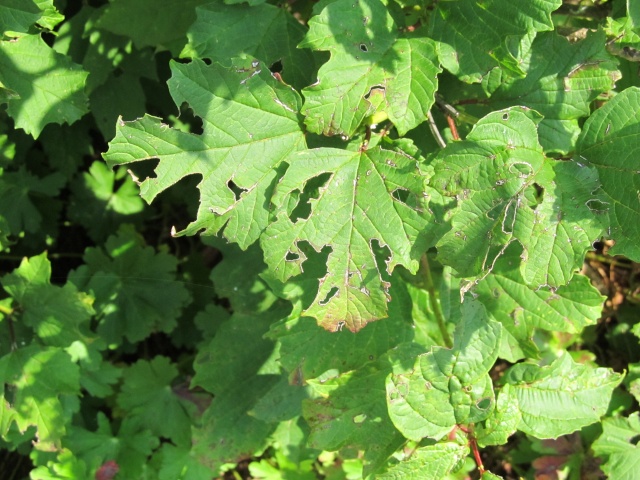
Both images show damaged foliage, but what caused the damage? Knowing the answer informs the response you might choose to make as a grower. The first picture is of damage done by the hungry mouths of Japanese Beetles. Spraying the damaged plant with a contact insecticide, like horticultural soap or something more toxic, such as Orthene, will not help unless the bugs are there at the time and are covered by the chemical. For all that, if the beetles are on the leaf you can simply hold a jar of soapy water under them, tap the leaf and they will fall in the solution and drown, which is about the least environmentally damaging way you can address the problem. Or, you can do it in the least environmentally sensitive way and sprinkle Sevin dust all over the plant, and then every bug that comes in contact with it - good or bad - will be subject to the toxic effects of the chemical (and as a note of interest, the active agent in Sevin, called Carbaryl, is listed as a likely carcinogen in humans.) What about the damage to the leaves shown in the second picture? That was done by hail. No pesticide application will help.
One thing I am always on the lookout for at this time of year are leaves that look like this:
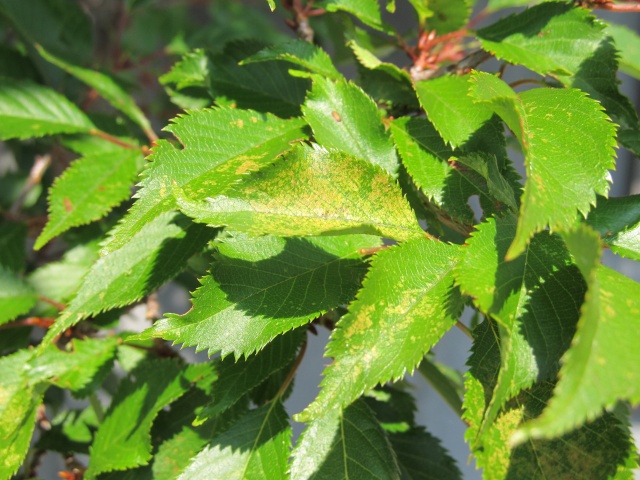
Flip over such leaves and you may find this:
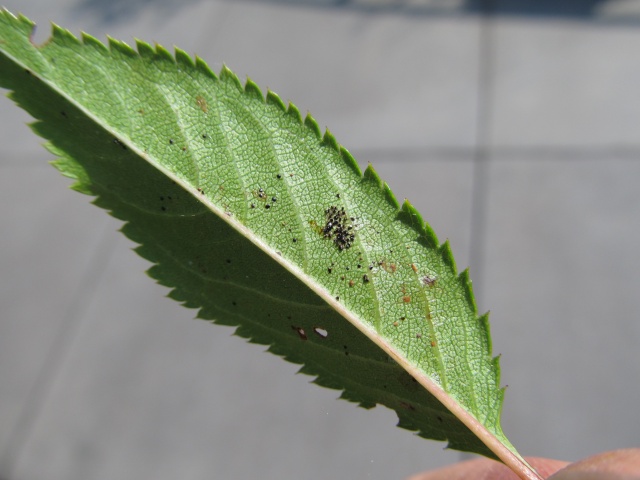
Are those little dark dots what is causing the damage on the top side of the leaf? No, those are the droppings of the creature that is damaging the leaves. Here is the culprit:
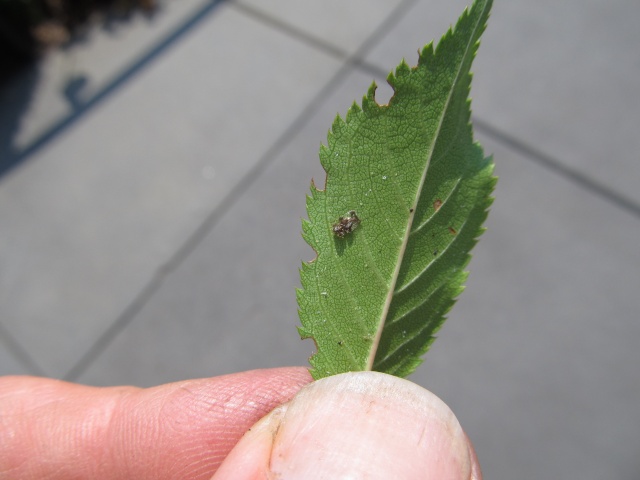
This is a Lace Bug, and the damage they do is by hiding on the underside of leaves and sucking plant juice out of them. They are amazing creatures to see under a microscope, very intricate and lace like in their appearance (hence the name). They are a persistent problem for my plants every summer:
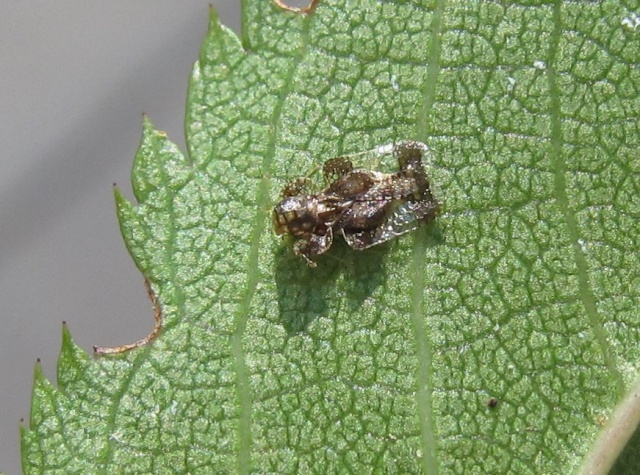
Lace bugs are easily treatable with low level insecticides like horticultural oil or horticultural soap. If I find them on a bonsai I will usually spray them. When Lace Bugs turn up on a larger plant in the garden I have a different method of control, which I will discuss a little later.
Here is another example of the benefits of closely observing your plants. I was walking past this Stewartia bonsai one day and something out of place caught my eye. I first thought a branch had been broken:
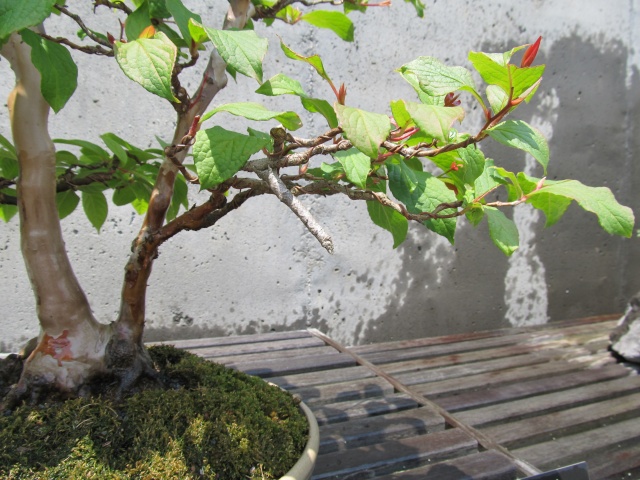
I moved in for a closer look:
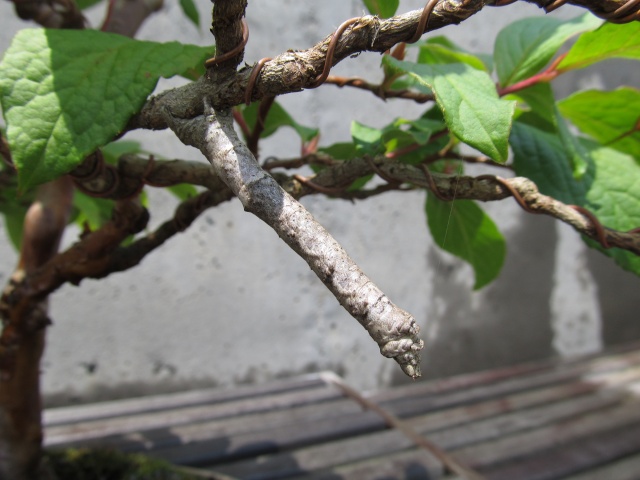
No need for insecticide in this case, just simple physical removal. I did not kill this caterpillar, I think just because he looked so cool, but I did airlift him out of the garden moments after this picture was made:
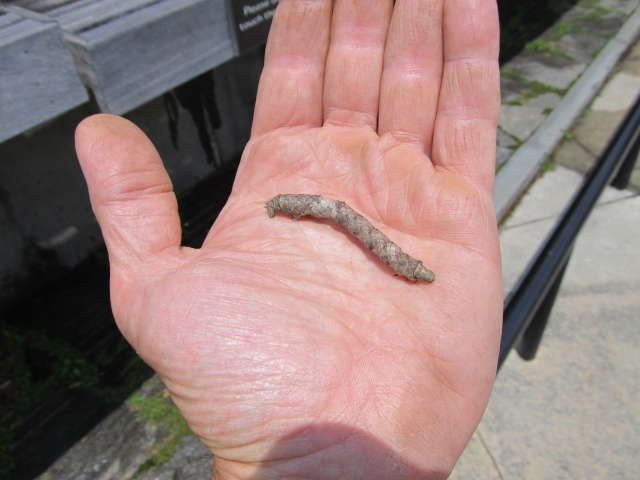
One truth quickly learned by being observant and studying the ways of nature is that the world is full of hungry things, and a great many of these things eat plants. As previously noted, those of us who grow plants tend to characterize those creatures that eat them as the bad guys, and in the same simplistic vernacular those creatures that eat the things that eat plants are the good guys. In Integrated Pest Management, one of the most effective tools in controlling the bad guys is promoting the presence of the good guys, also known as the beneficials. In the last 2 years I have released thousands of beneficial insects in the Bonsai Exhibition Garden, as well as in the hoop house where we grow the bonsai not on display in the garden. I purchase them mail order from a company called Biobest (http://www.biobest.be/home/3/), but there are other suppliers out there and a web search for beneficial insect suppliers will provide leads.
Although I have bought and released several different beneficial species, the one I have used the most looks like this:

Actually, they do not look like that when I release them. The picture shows an adult Lacewing, which feeds primarily on nectar. What I release are their larval form, sometimes called Aphid Lions, which are so tiny when I get them that they are difficult to see without a magnifying lens. They are voracious feeders who especially enjoy aphids but also eat a broad spectrum of other bugs and insects, including each other if there are not sufficient alternatives available. Lacewings are my weapon of choice to combat Lace Bugs when they turn up on landscape plants in the garden.
The hope when beneficials are released is that they will not only eat a great number of pests, but will also reproduce and establish a lasting presence. I know Lacewings are doing that in our garden because I have seen this evidence:

Look very closely at the leaf in the very center of the picture and you will see tiny white dots dangling from its underside. Those are Lacewing eggs, each suspended by a thread which separates them from each other, presumably so they do not devour their siblings upon arrival.
Several common garden insects are well known beneficials, such as the Praying Mantis:

And the Lady Beetle (these 2 here shown in the act of creating more beneficials - way to go girls!):

Most people know these are "good bugs" and will not harm them, but what if they happen to get sprayed by insecticides being put out for pest species? Then they die, and all the pests they might have eaten get to live. This is one reason why it is important to be careful when choosing to apply insecticides - you may inadvertently be undermining nature's own pest control. Look for the presence of beneficials before you resort to chemicals, and if you see them, consider giving them time to work. Of course, you have to know what you are looking for. There are so many different species of bugs and insects and they do not wear white hats and black hats so you can tell them apart. Take this one for example:
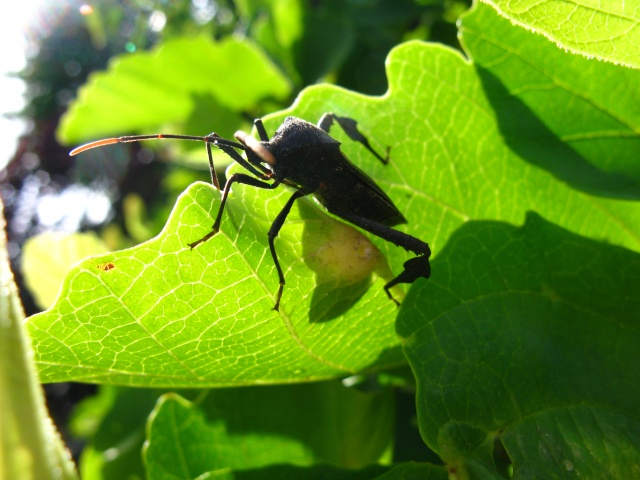
Good guy or bad guy? Looks kind of creepy, and has a creepy name too - Assassin Bug... but, it is a beneficial.
Of course there are a lot of beneficials that are not insects or bugs. The Bonsai Exhibition Garden has an impressive population of insect eating skinks and lizards, such as this Eastern Fence Lizard:
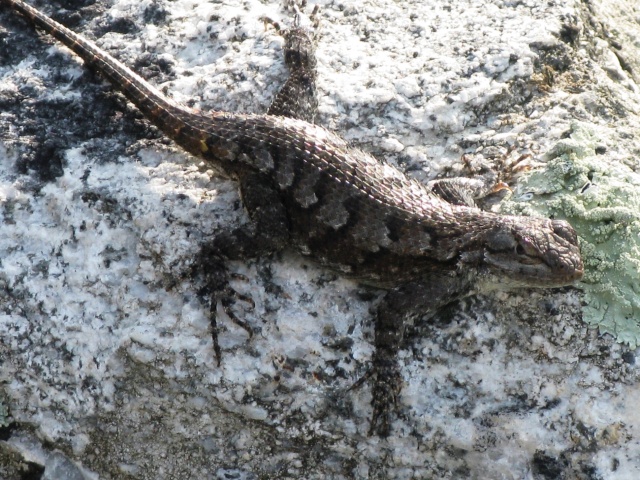
Reptiles, birds, small mammals - there are many creatures that live by eating insects. Their presence in your garden or in the vicinity of your bonsai can work to your benefit, so it makes sense to promote their well being. Part of what they need to survive is food, and their food in large part are the bugs and insects that eat your plants, and this means there needs to be some of them present, too. Wait a minute... in order to have a healthy presence of the beneficials there has to be a presence of the pests? This would seem to mean that it is in some way desirable to have about a certain population of the very things we do not want to have. This is all too confusing. Would it not be easier just to kill everything???
As I said before, it gets complicated.
The greatest aid to learning about the environment around you is to be observant. I spend a great deal of time at work just looking - at the bonsai, at the plants in the garden. Part of this is related to design decisions, such as, should I remove that lowest branch? Should I replace those pink flowering azaleas with something other that has blooms more in harmony with the garden's overall color scheme? But another part of my looking has to do with appearances as they relate to the health of the plants. That plant looks a little droopy - why? The leaves on that plant are damaged - what did it? Here are 2 examples:


Both images show damaged foliage, but what caused the damage? Knowing the answer informs the response you might choose to make as a grower. The first picture is of damage done by the hungry mouths of Japanese Beetles. Spraying the damaged plant with a contact insecticide, like horticultural soap or something more toxic, such as Orthene, will not help unless the bugs are there at the time and are covered by the chemical. For all that, if the beetles are on the leaf you can simply hold a jar of soapy water under them, tap the leaf and they will fall in the solution and drown, which is about the least environmentally damaging way you can address the problem. Or, you can do it in the least environmentally sensitive way and sprinkle Sevin dust all over the plant, and then every bug that comes in contact with it - good or bad - will be subject to the toxic effects of the chemical (and as a note of interest, the active agent in Sevin, called Carbaryl, is listed as a likely carcinogen in humans.) What about the damage to the leaves shown in the second picture? That was done by hail. No pesticide application will help.
One thing I am always on the lookout for at this time of year are leaves that look like this:

Flip over such leaves and you may find this:

Are those little dark dots what is causing the damage on the top side of the leaf? No, those are the droppings of the creature that is damaging the leaves. Here is the culprit:

This is a Lace Bug, and the damage they do is by hiding on the underside of leaves and sucking plant juice out of them. They are amazing creatures to see under a microscope, very intricate and lace like in their appearance (hence the name). They are a persistent problem for my plants every summer:

Lace bugs are easily treatable with low level insecticides like horticultural oil or horticultural soap. If I find them on a bonsai I will usually spray them. When Lace Bugs turn up on a larger plant in the garden I have a different method of control, which I will discuss a little later.
Here is another example of the benefits of closely observing your plants. I was walking past this Stewartia bonsai one day and something out of place caught my eye. I first thought a branch had been broken:

I moved in for a closer look:

No need for insecticide in this case, just simple physical removal. I did not kill this caterpillar, I think just because he looked so cool, but I did airlift him out of the garden moments after this picture was made:

One truth quickly learned by being observant and studying the ways of nature is that the world is full of hungry things, and a great many of these things eat plants. As previously noted, those of us who grow plants tend to characterize those creatures that eat them as the bad guys, and in the same simplistic vernacular those creatures that eat the things that eat plants are the good guys. In Integrated Pest Management, one of the most effective tools in controlling the bad guys is promoting the presence of the good guys, also known as the beneficials. In the last 2 years I have released thousands of beneficial insects in the Bonsai Exhibition Garden, as well as in the hoop house where we grow the bonsai not on display in the garden. I purchase them mail order from a company called Biobest (http://www.biobest.be/home/3/), but there are other suppliers out there and a web search for beneficial insect suppliers will provide leads.
Although I have bought and released several different beneficial species, the one I have used the most looks like this:

Actually, they do not look like that when I release them. The picture shows an adult Lacewing, which feeds primarily on nectar. What I release are their larval form, sometimes called Aphid Lions, which are so tiny when I get them that they are difficult to see without a magnifying lens. They are voracious feeders who especially enjoy aphids but also eat a broad spectrum of other bugs and insects, including each other if there are not sufficient alternatives available. Lacewings are my weapon of choice to combat Lace Bugs when they turn up on landscape plants in the garden.
The hope when beneficials are released is that they will not only eat a great number of pests, but will also reproduce and establish a lasting presence. I know Lacewings are doing that in our garden because I have seen this evidence:

Look very closely at the leaf in the very center of the picture and you will see tiny white dots dangling from its underside. Those are Lacewing eggs, each suspended by a thread which separates them from each other, presumably so they do not devour their siblings upon arrival.
Several common garden insects are well known beneficials, such as the Praying Mantis:

And the Lady Beetle (these 2 here shown in the act of creating more beneficials - way to go girls!):

Most people know these are "good bugs" and will not harm them, but what if they happen to get sprayed by insecticides being put out for pest species? Then they die, and all the pests they might have eaten get to live. This is one reason why it is important to be careful when choosing to apply insecticides - you may inadvertently be undermining nature's own pest control. Look for the presence of beneficials before you resort to chemicals, and if you see them, consider giving them time to work. Of course, you have to know what you are looking for. There are so many different species of bugs and insects and they do not wear white hats and black hats so you can tell them apart. Take this one for example:

Good guy or bad guy? Looks kind of creepy, and has a creepy name too - Assassin Bug... but, it is a beneficial.
Of course there are a lot of beneficials that are not insects or bugs. The Bonsai Exhibition Garden has an impressive population of insect eating skinks and lizards, such as this Eastern Fence Lizard:

Reptiles, birds, small mammals - there are many creatures that live by eating insects. Their presence in your garden or in the vicinity of your bonsai can work to your benefit, so it makes sense to promote their well being. Part of what they need to survive is food, and their food in large part are the bugs and insects that eat your plants, and this means there needs to be some of them present, too. Wait a minute... in order to have a healthy presence of the beneficials there has to be a presence of the pests? This would seem to mean that it is in some way desirable to have about a certain population of the very things we do not want to have. This is all too confusing. Would it not be easier just to kill everything???
As I said before, it gets complicated.

Arthur Joura- Member
 Re: American Bonsai at the NC Arboretum
Re: American Bonsai at the NC Arboretum
It is complicated, so thanks for helping it become a bit simpler.
If you look in our section that deals with sick or damaged plants -- -- it is obvious that many bonsaiests are convinced that the only good bug is a dead bug. We try to suggest remedies other than the nuclear option of spraying everything in sight. This will be a big help.
If you look in our section that deals with sick or damaged plants -- -- it is obvious that many bonsaiests are convinced that the only good bug is a dead bug. We try to suggest remedies other than the nuclear option of spraying everything in sight. This will be a big help.

JimLewis- Member
Page 2 of 40 •  1, 2, 3 ... 21 ... 40
1, 2, 3 ... 21 ... 40 
 Similar topics
Similar topics» American Bonsai at the NC Arboretum
» WISTERIA BONSAI AT INTERNATIONAL BONSAI ARBORETUM
» Ashville arboretum bonsai
» Trip to the Rochester Arboretum
» Carolina Bonsai Expo @ NC Arboretum
» WISTERIA BONSAI AT INTERNATIONAL BONSAI ARBORETUM
» Ashville arboretum bonsai
» Trip to the Rochester Arboretum
» Carolina Bonsai Expo @ NC Arboretum
Page 2 of 40
Permissions in this forum:
You cannot reply to topics in this forum|
|
|







